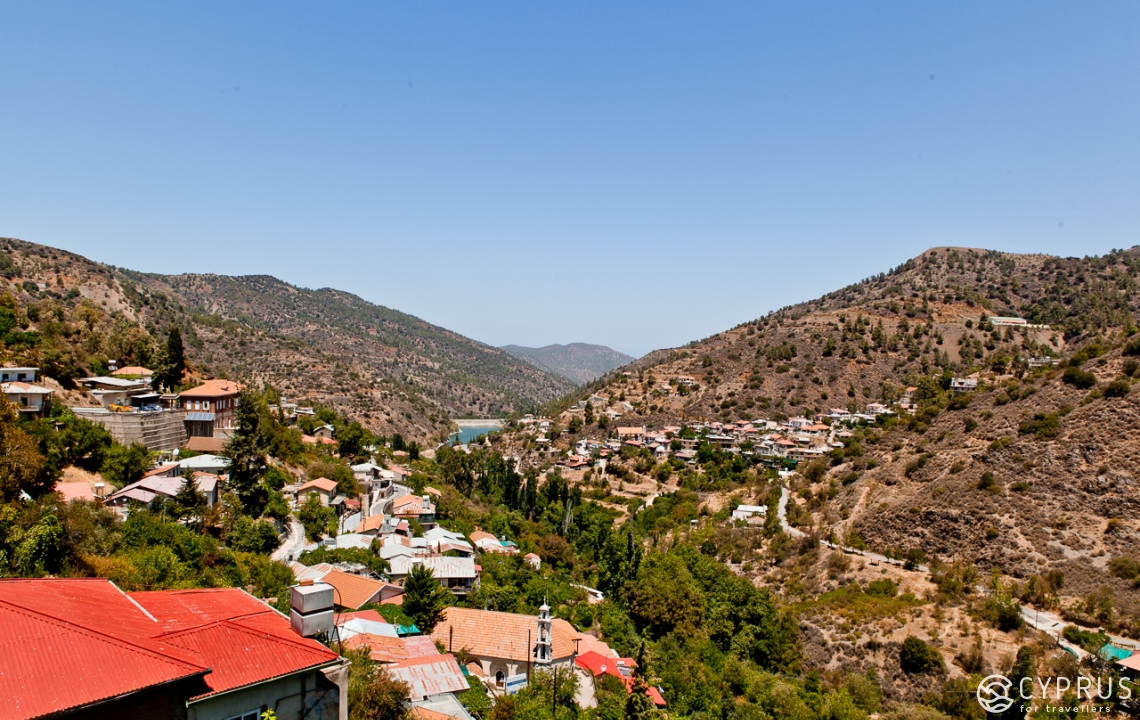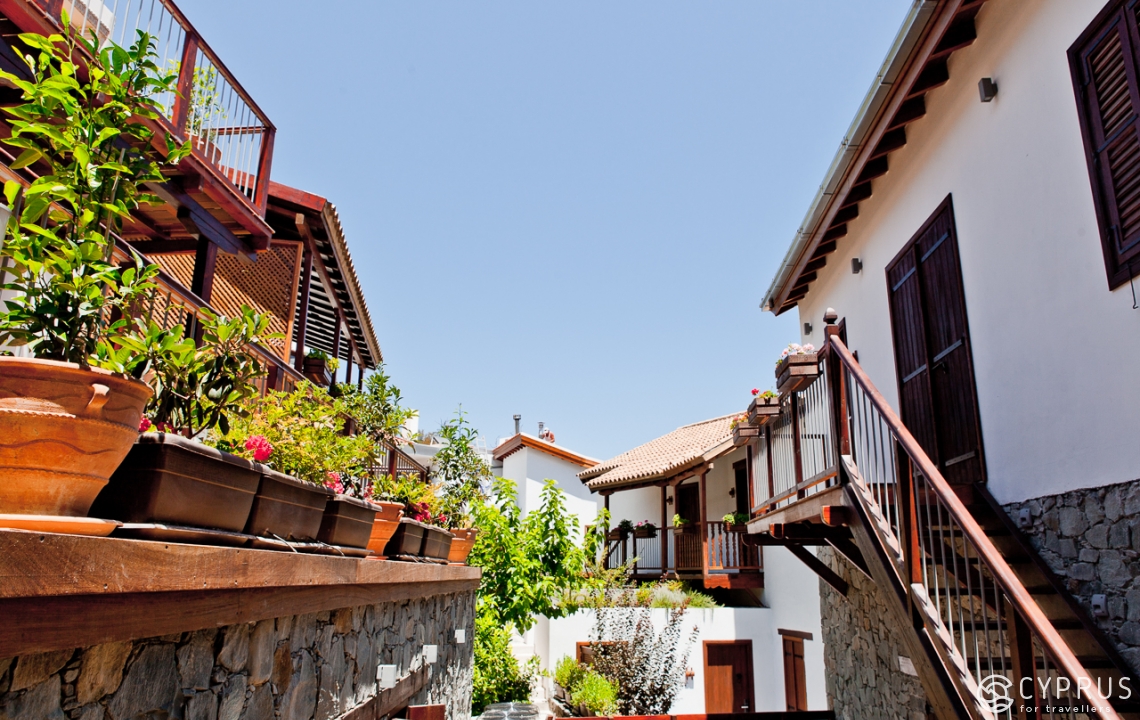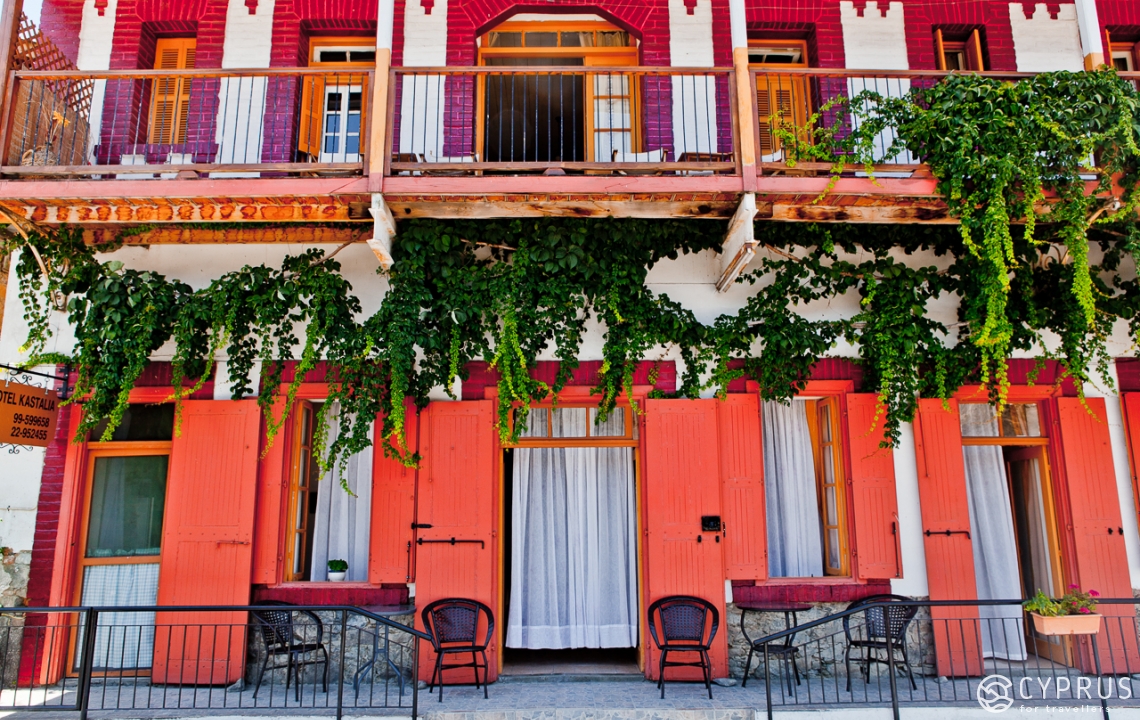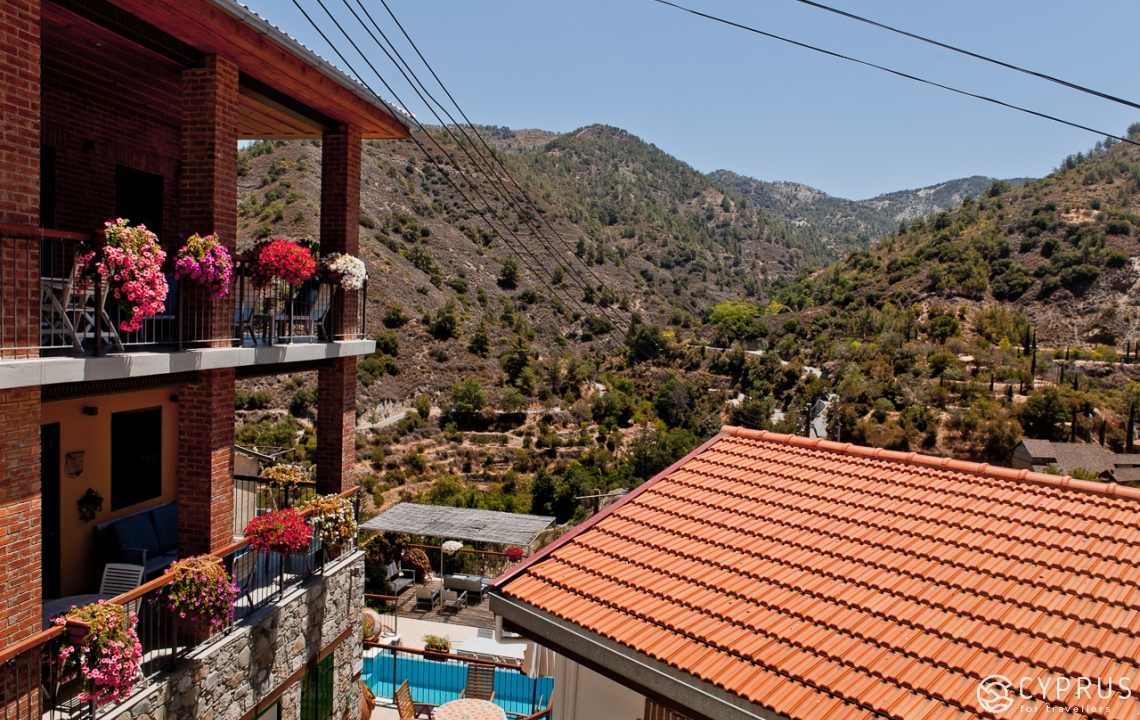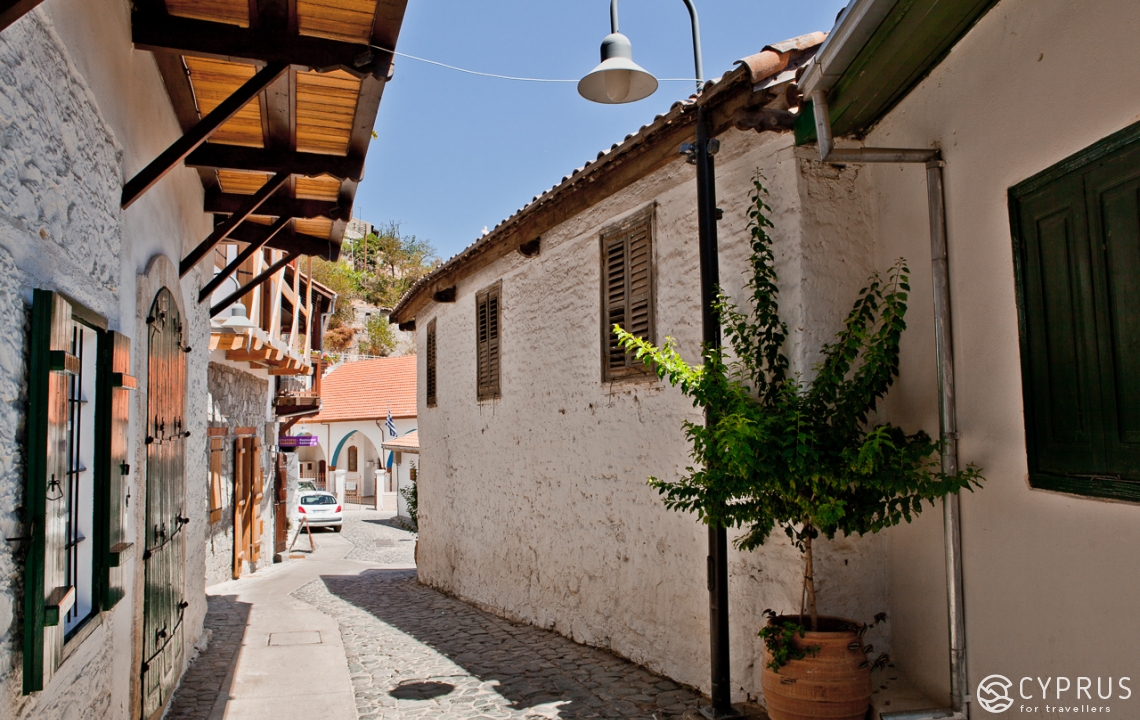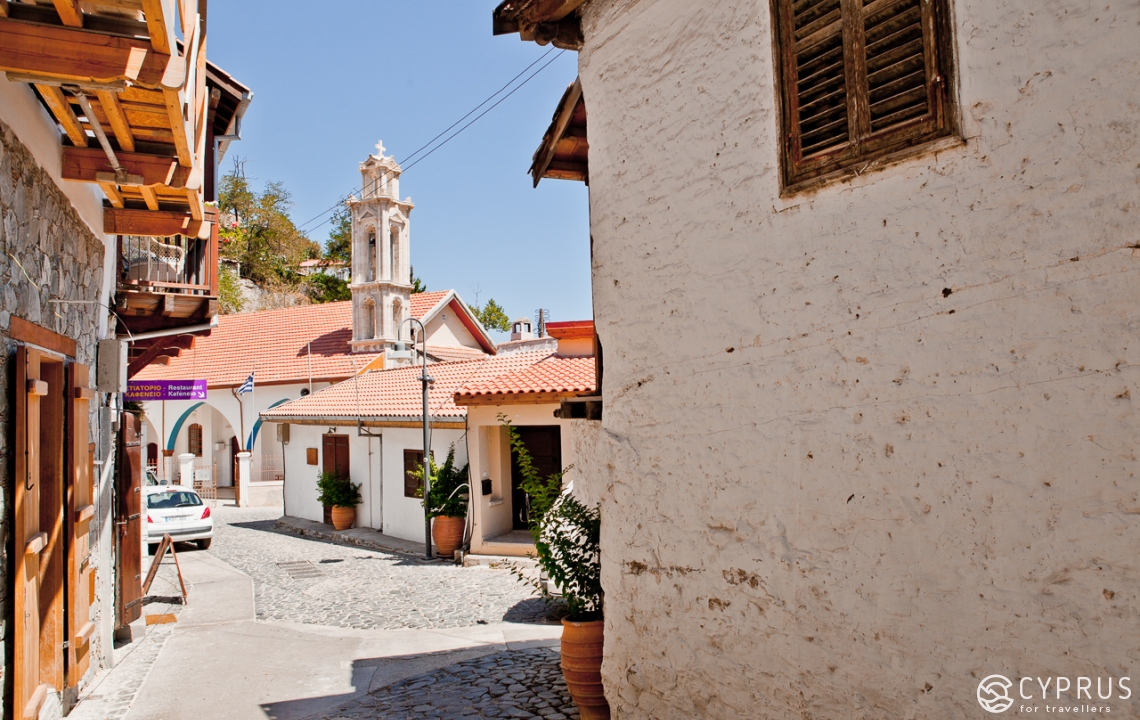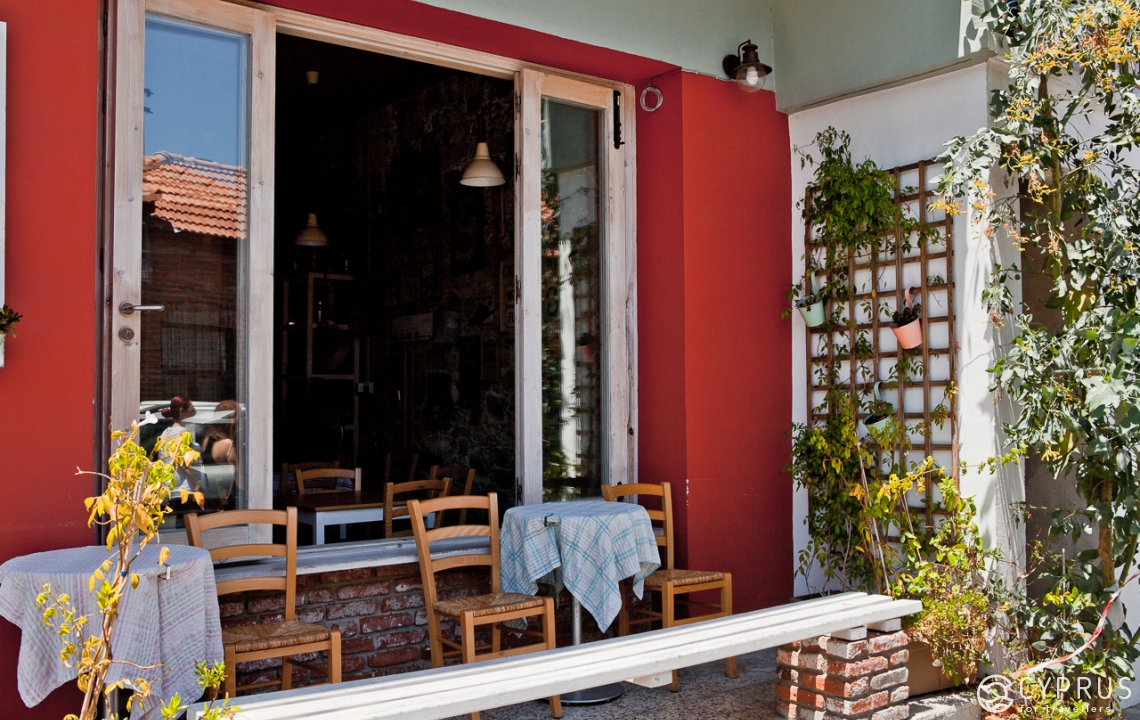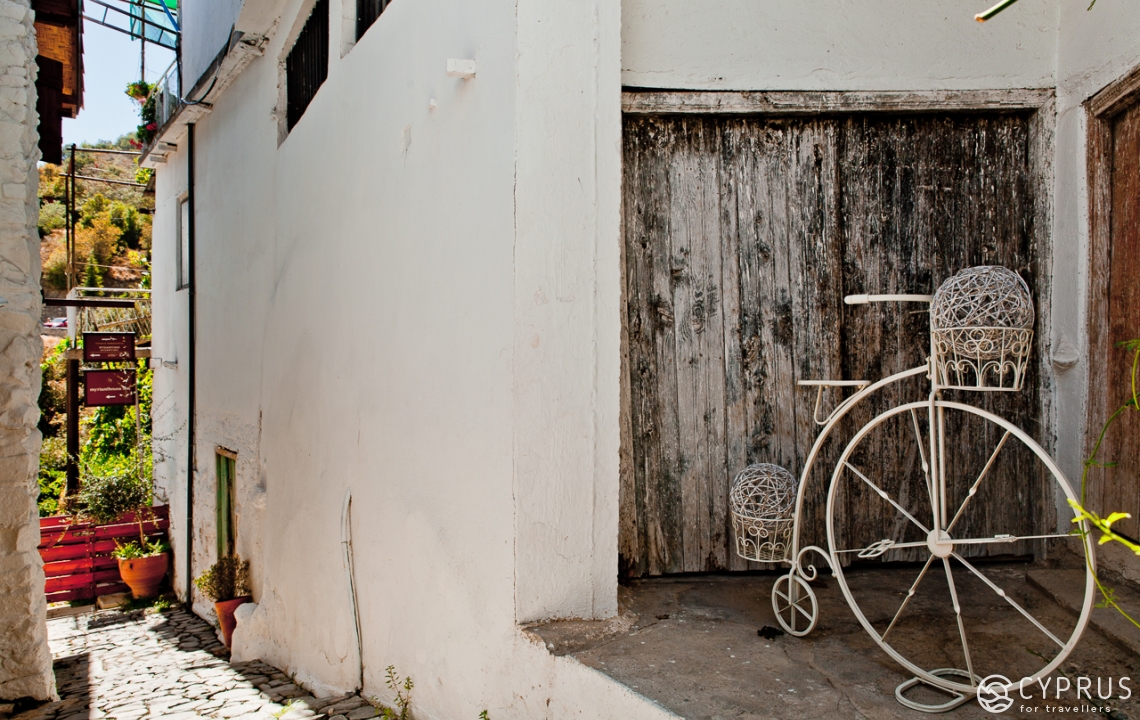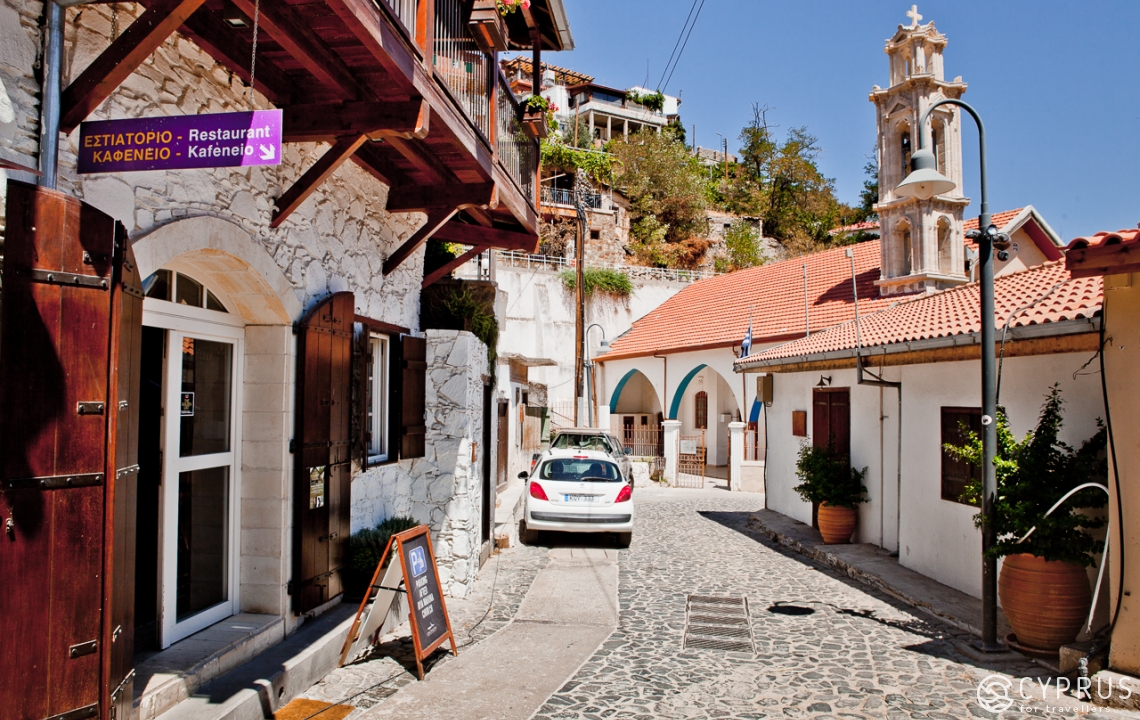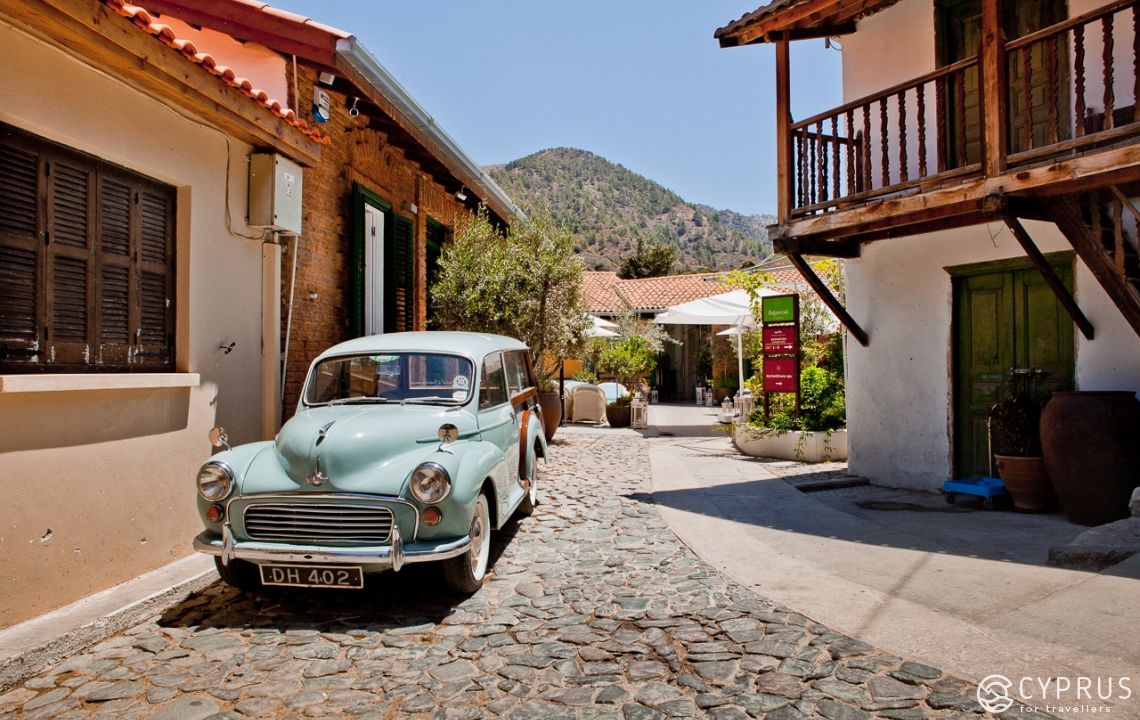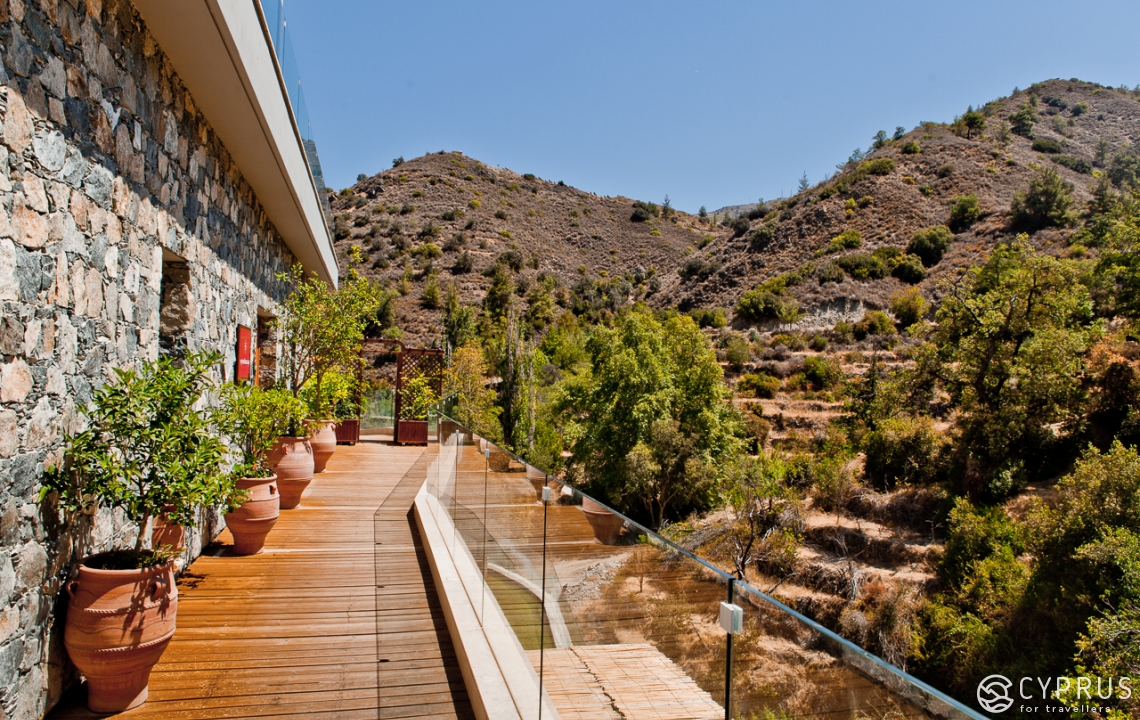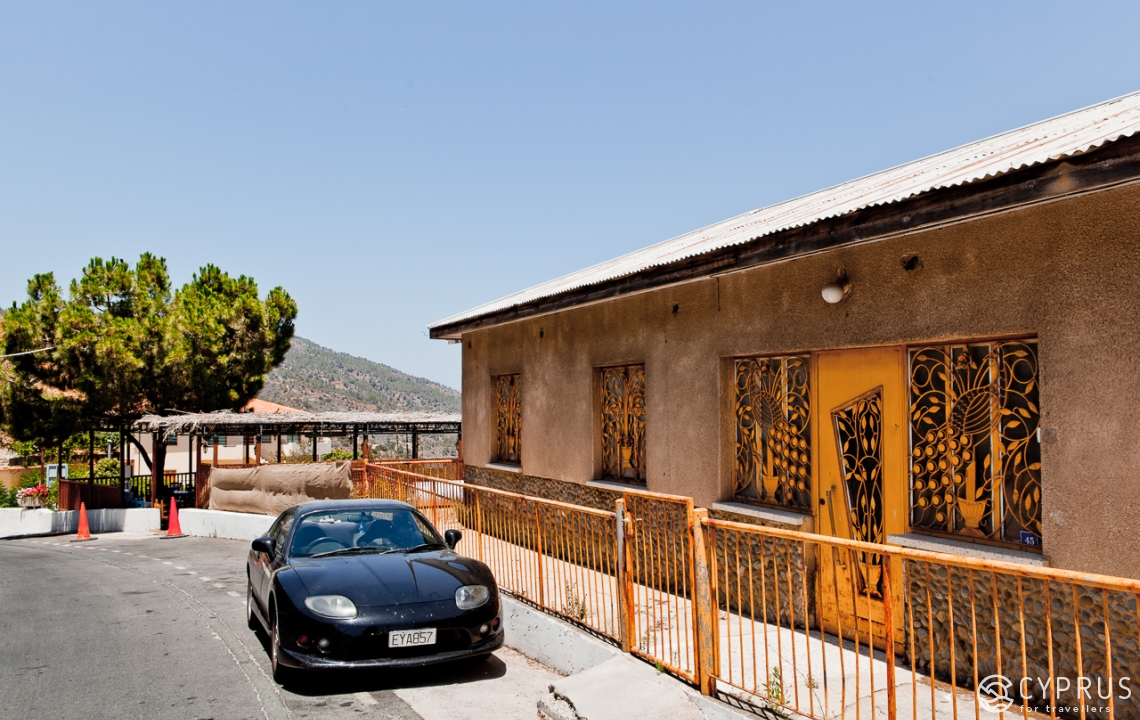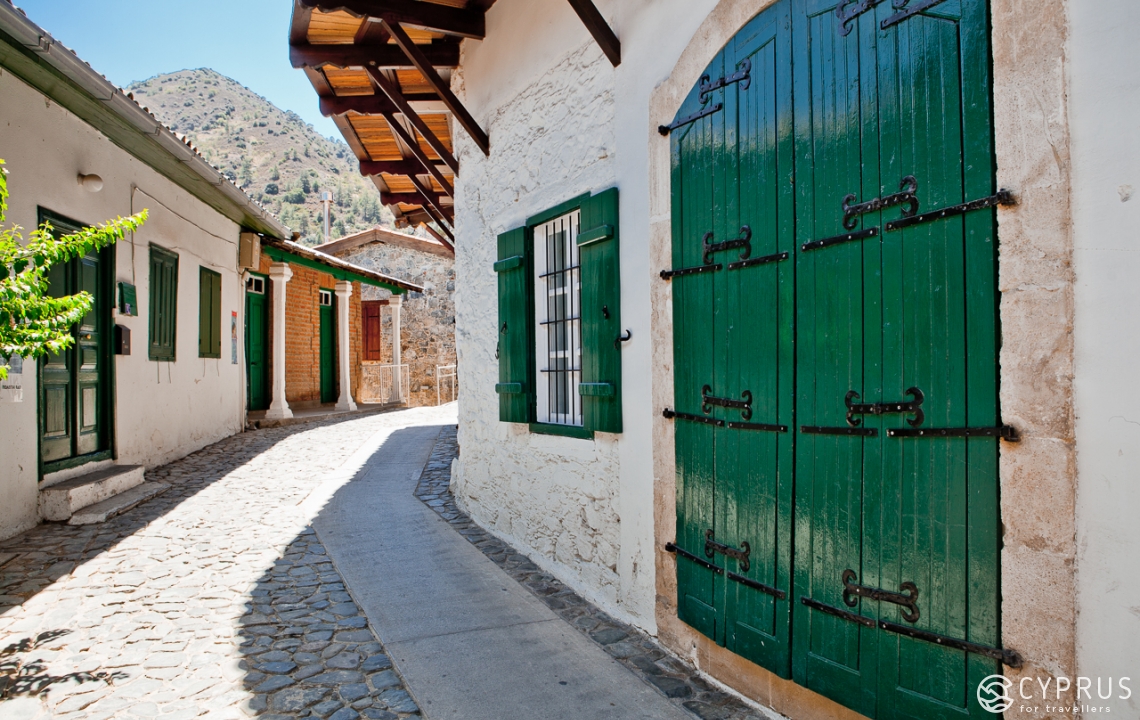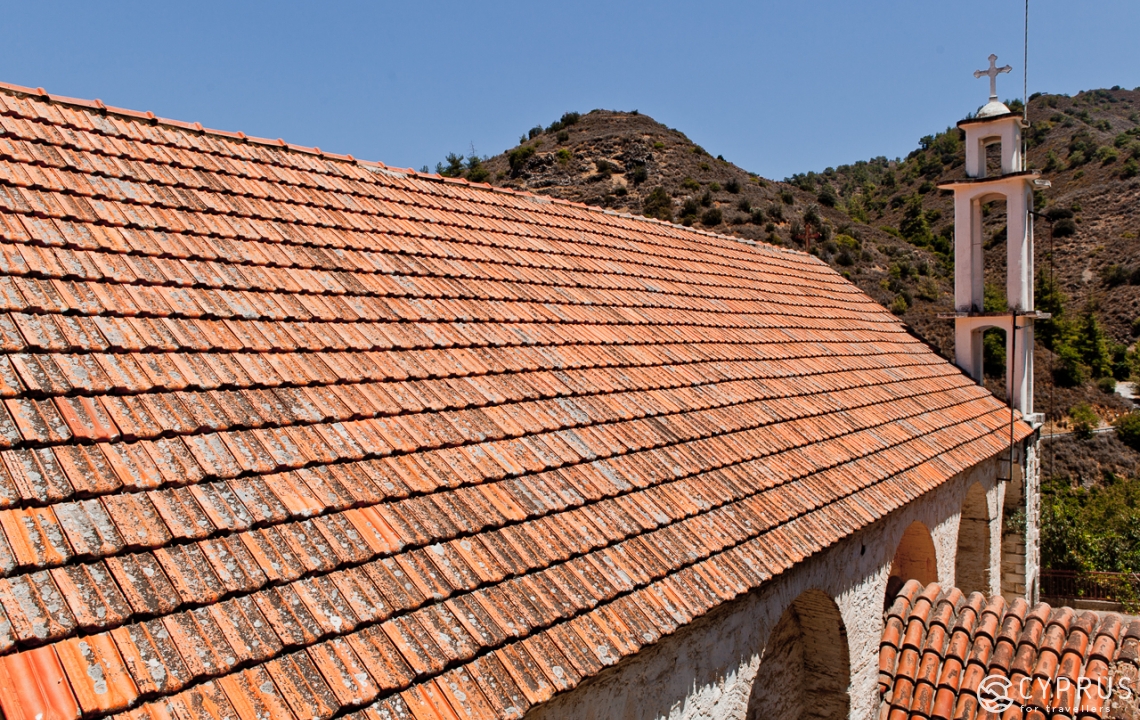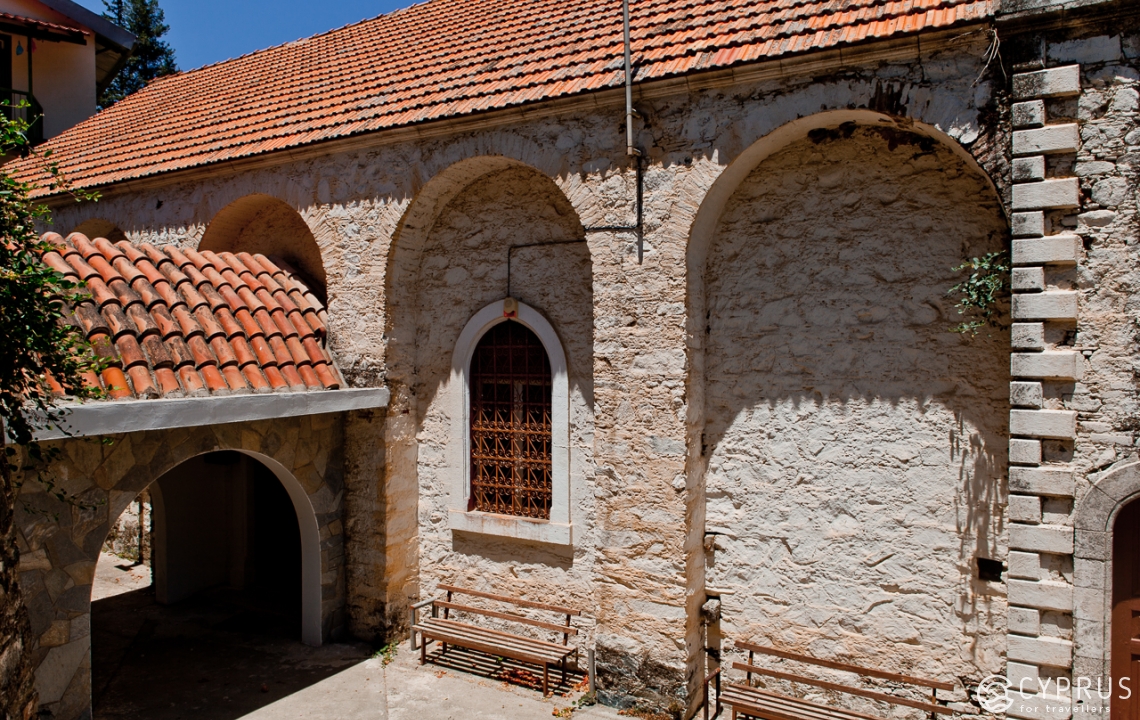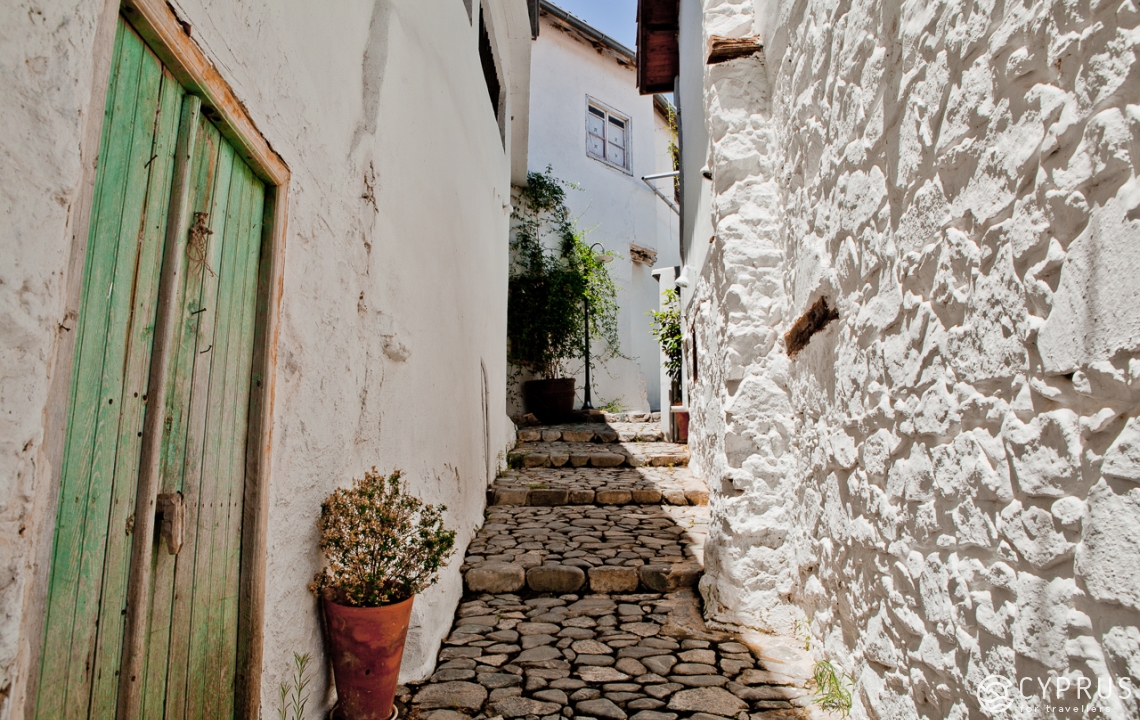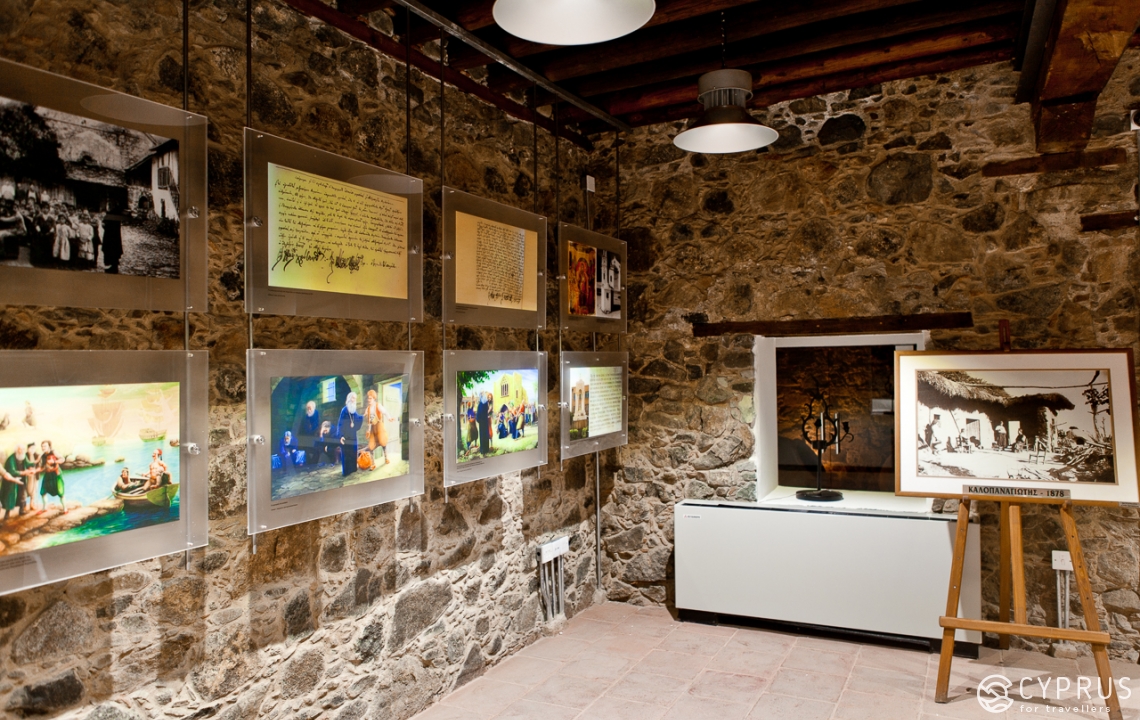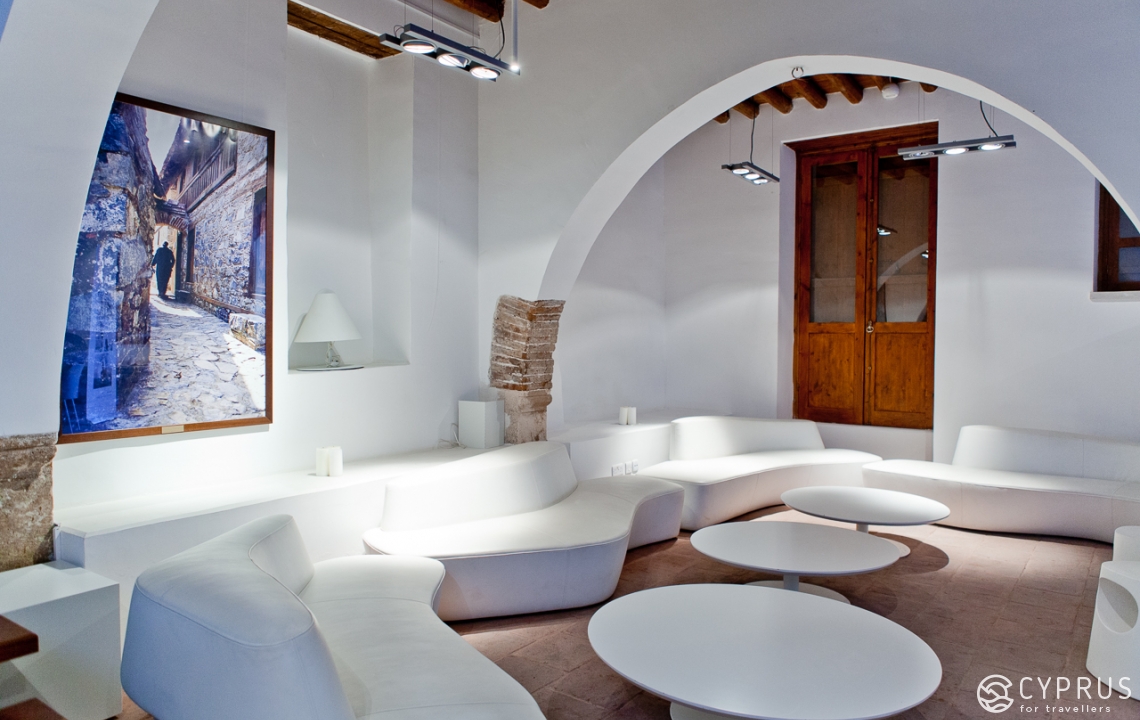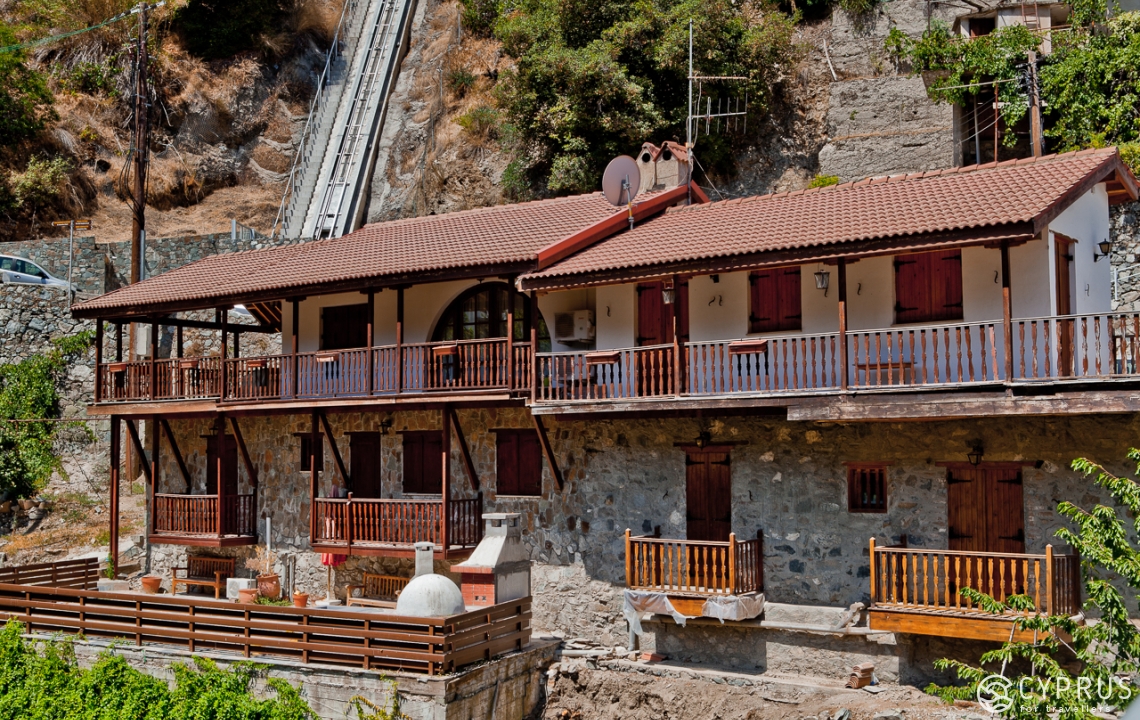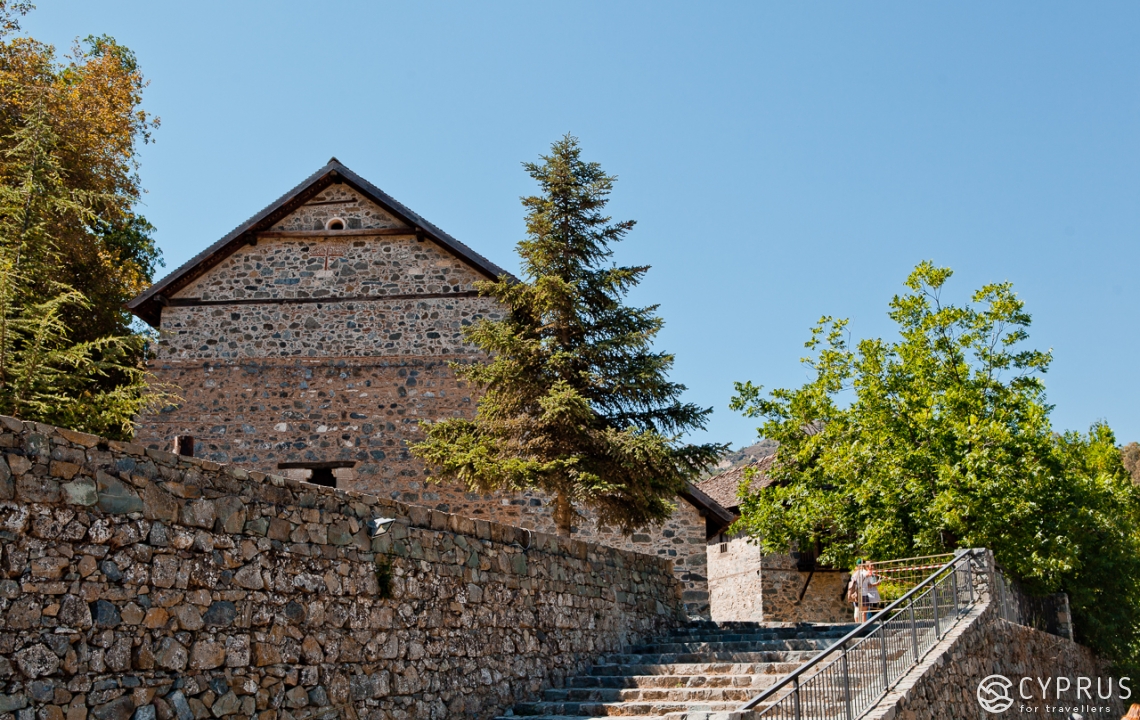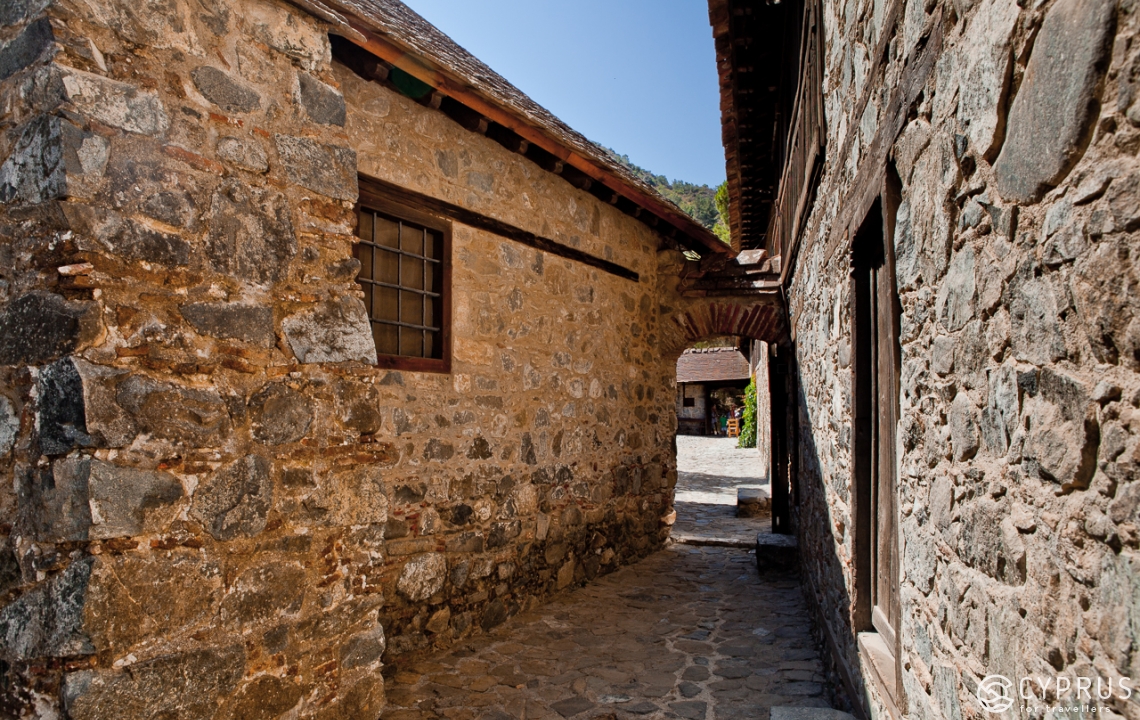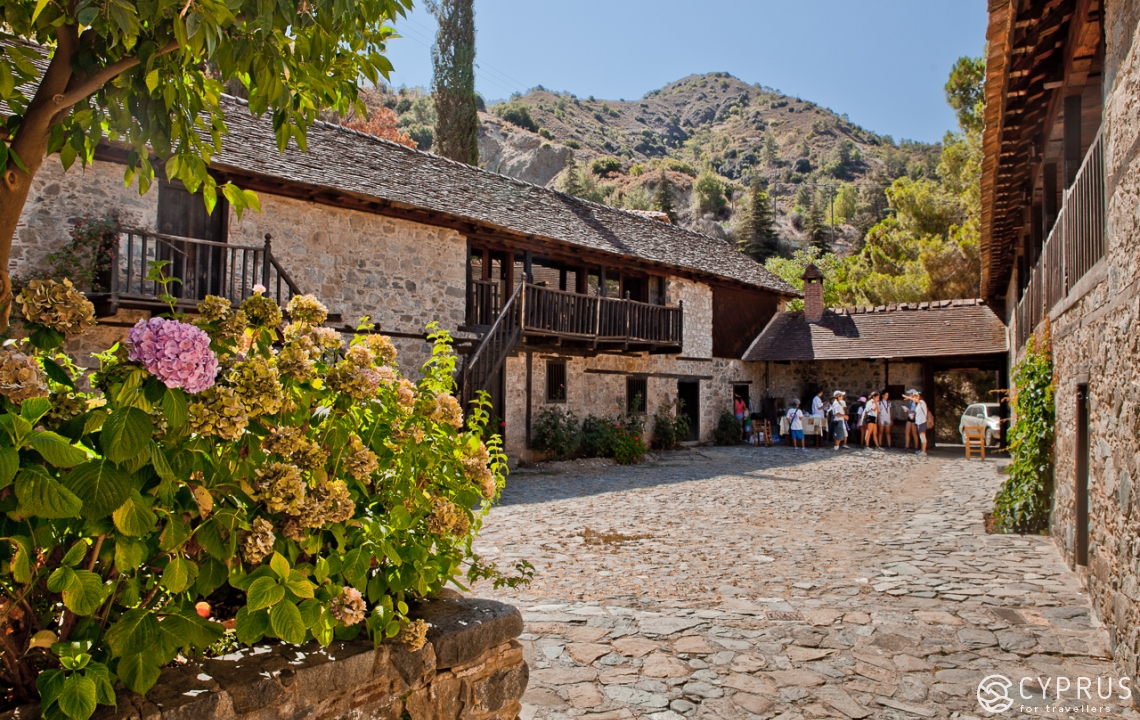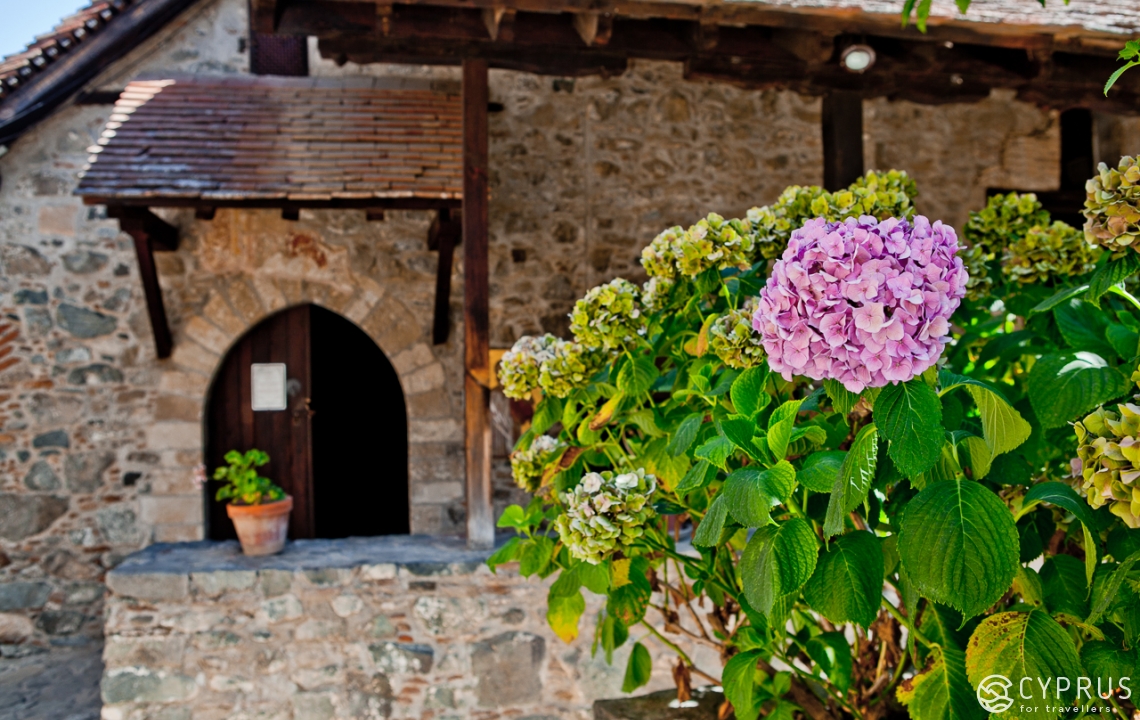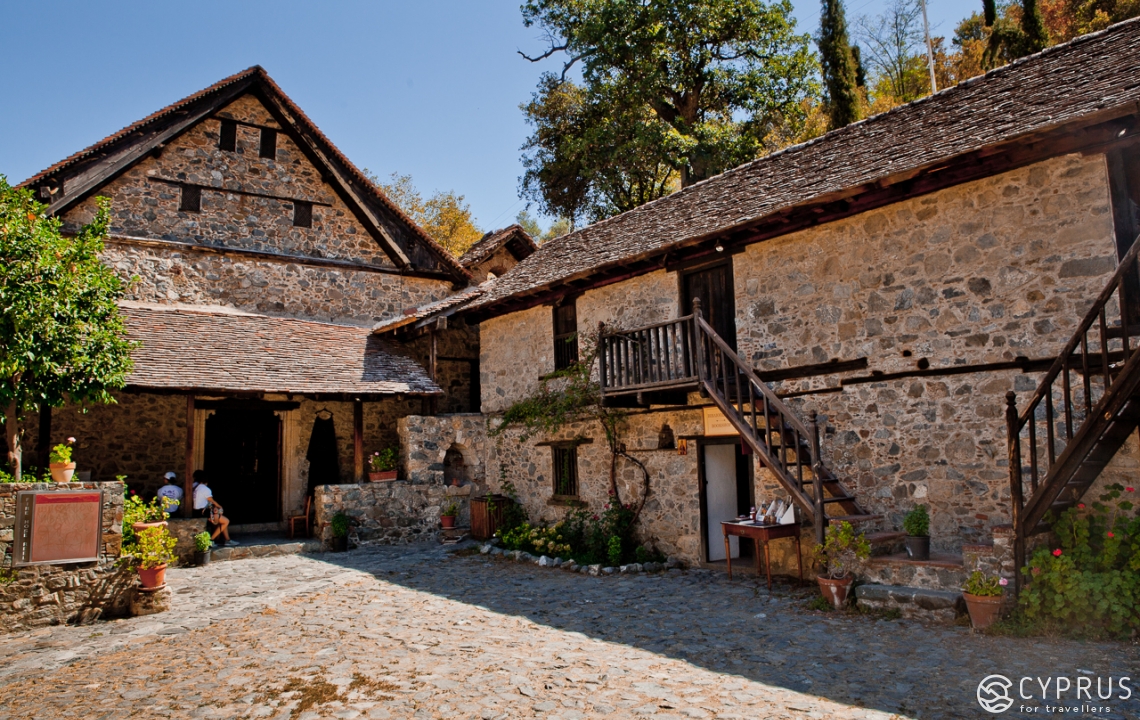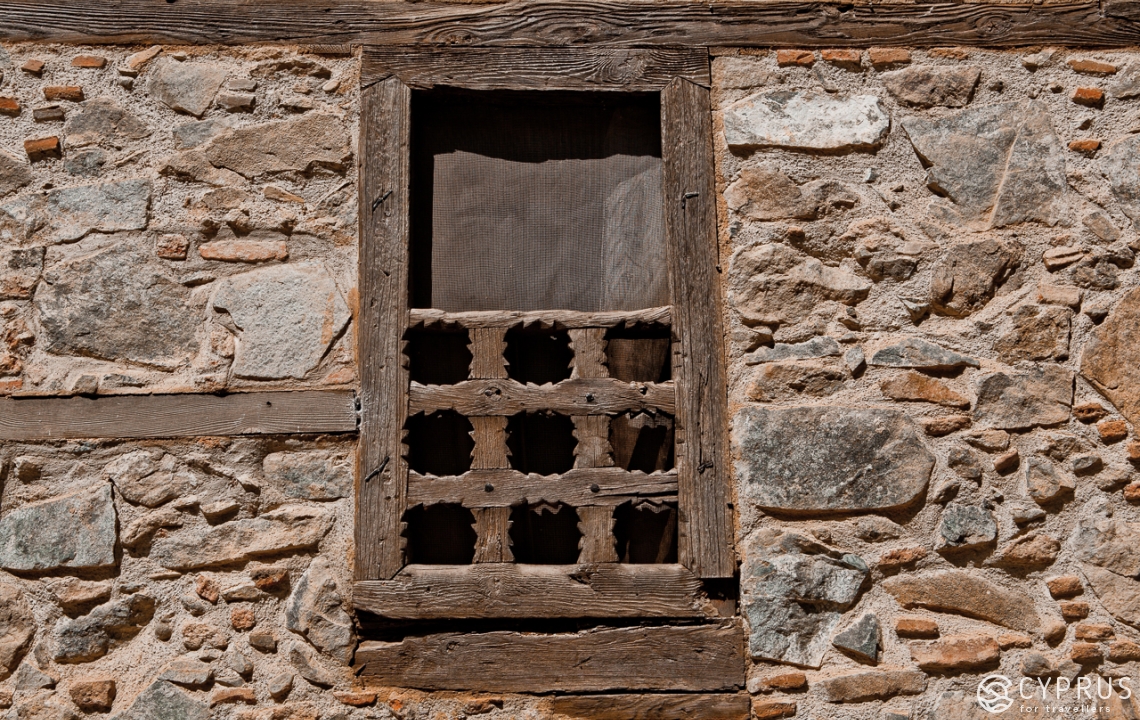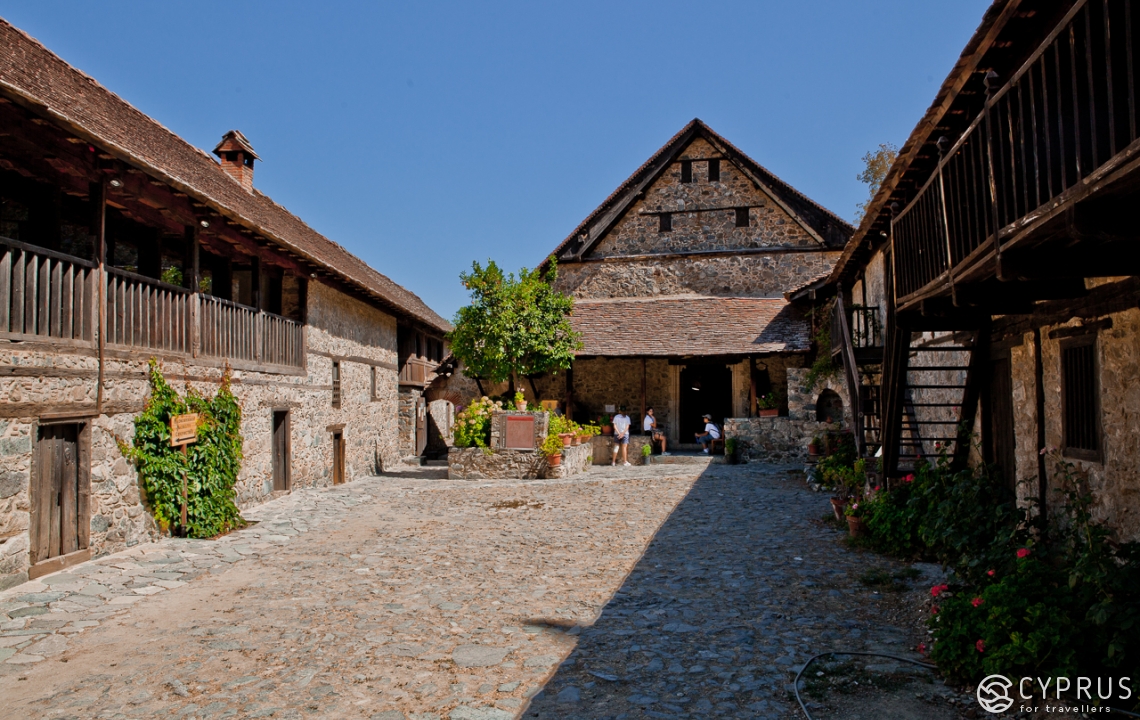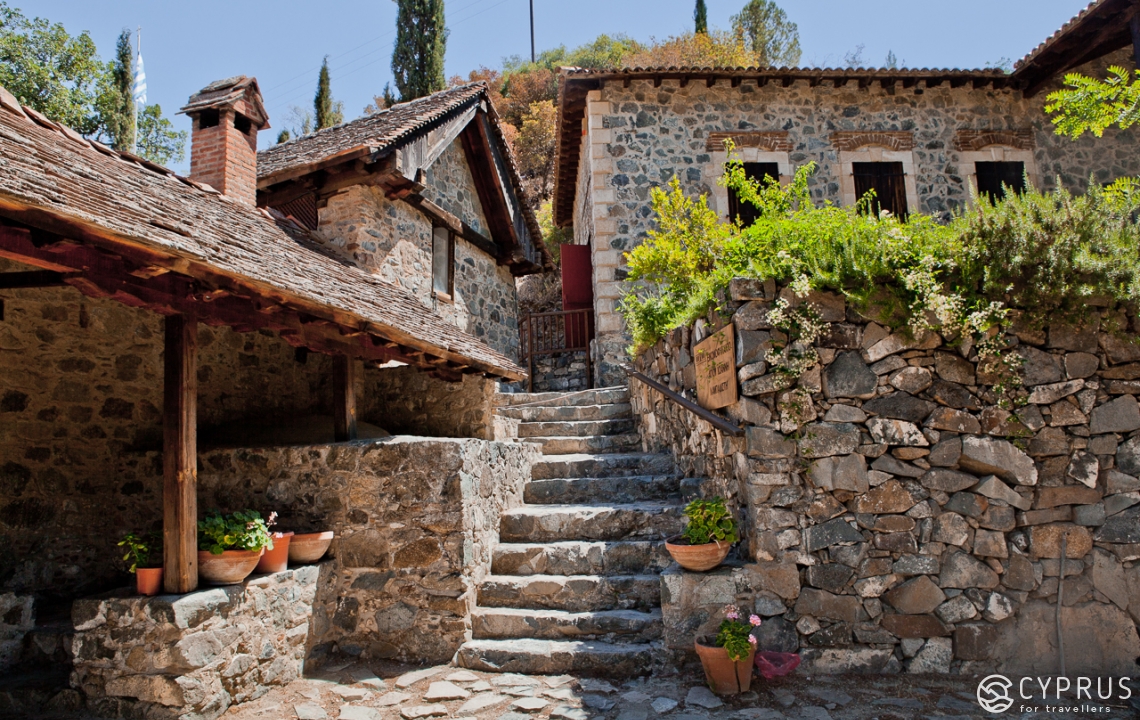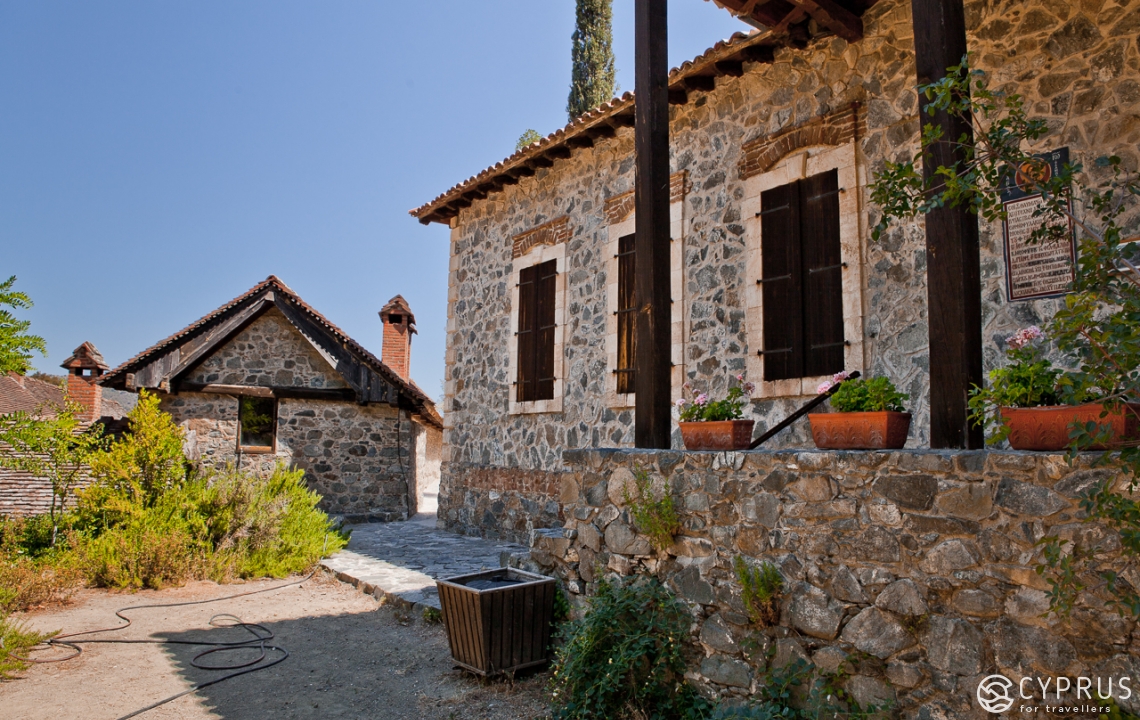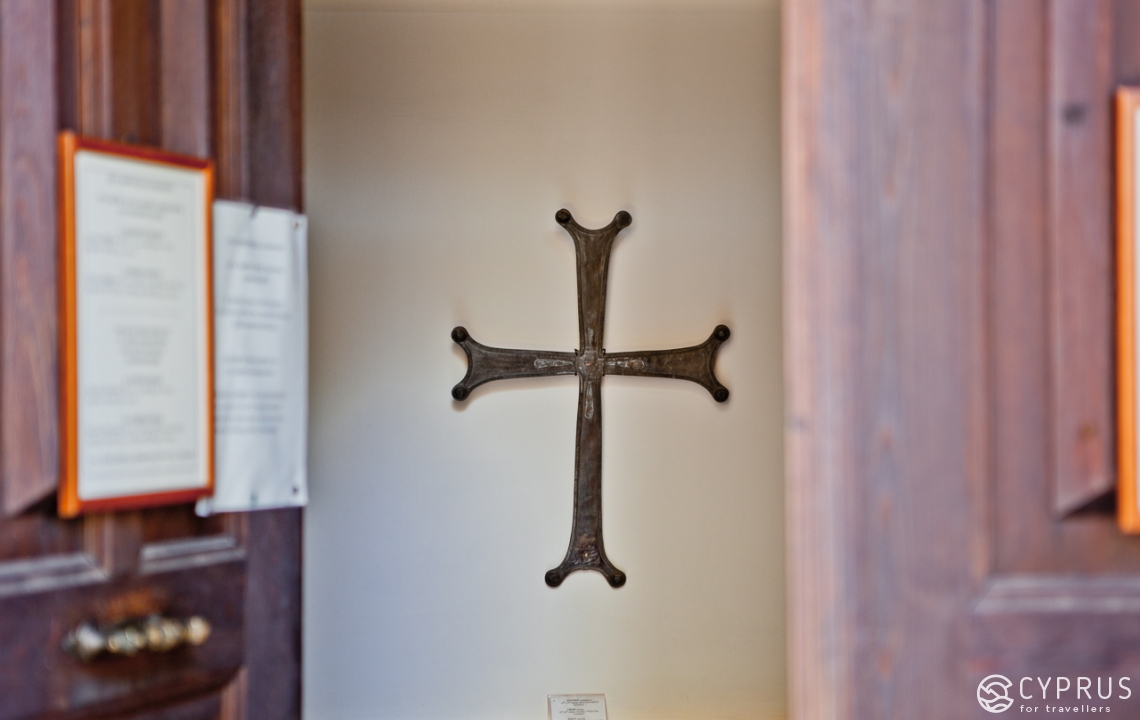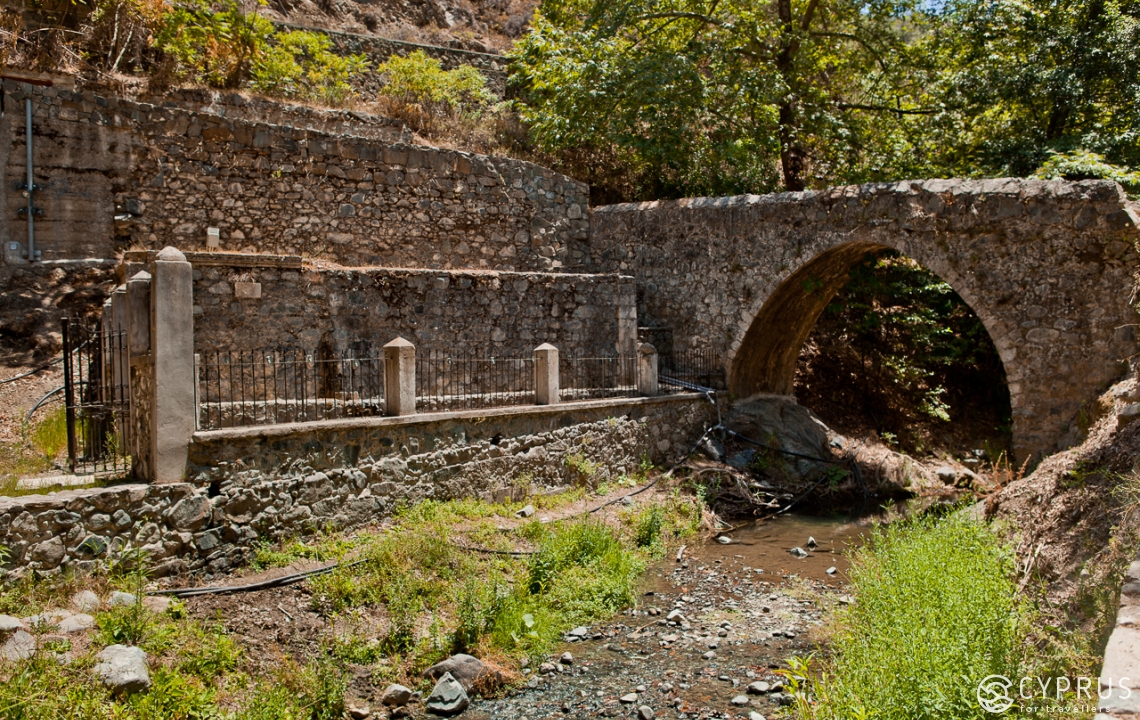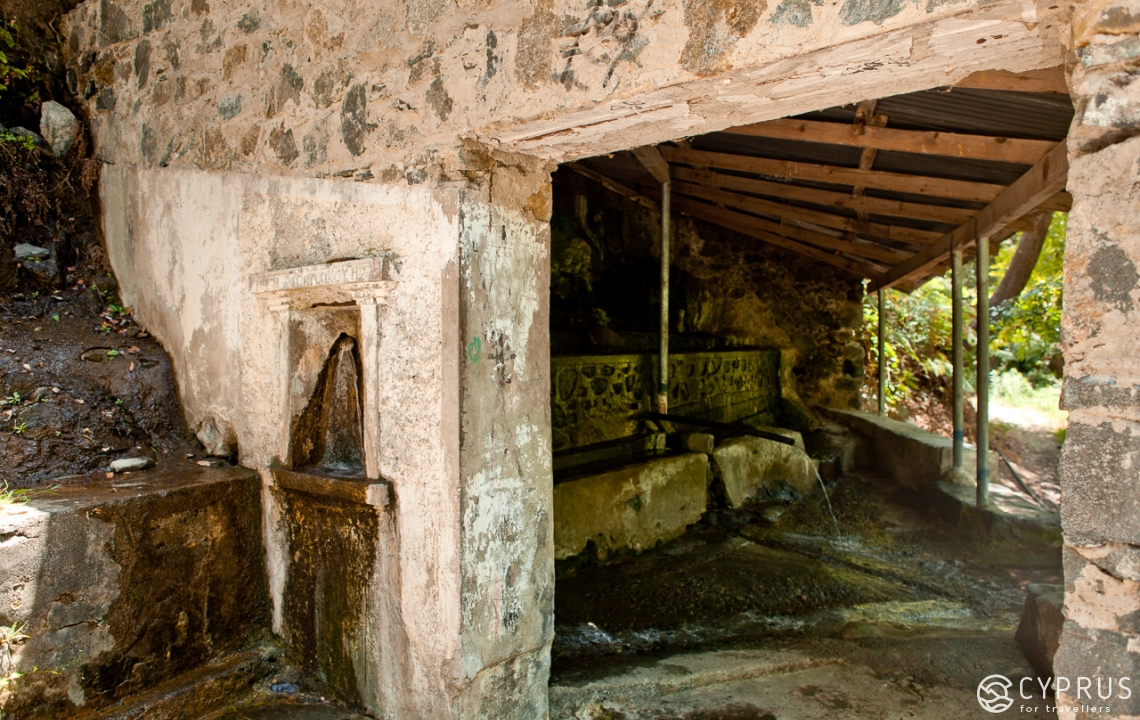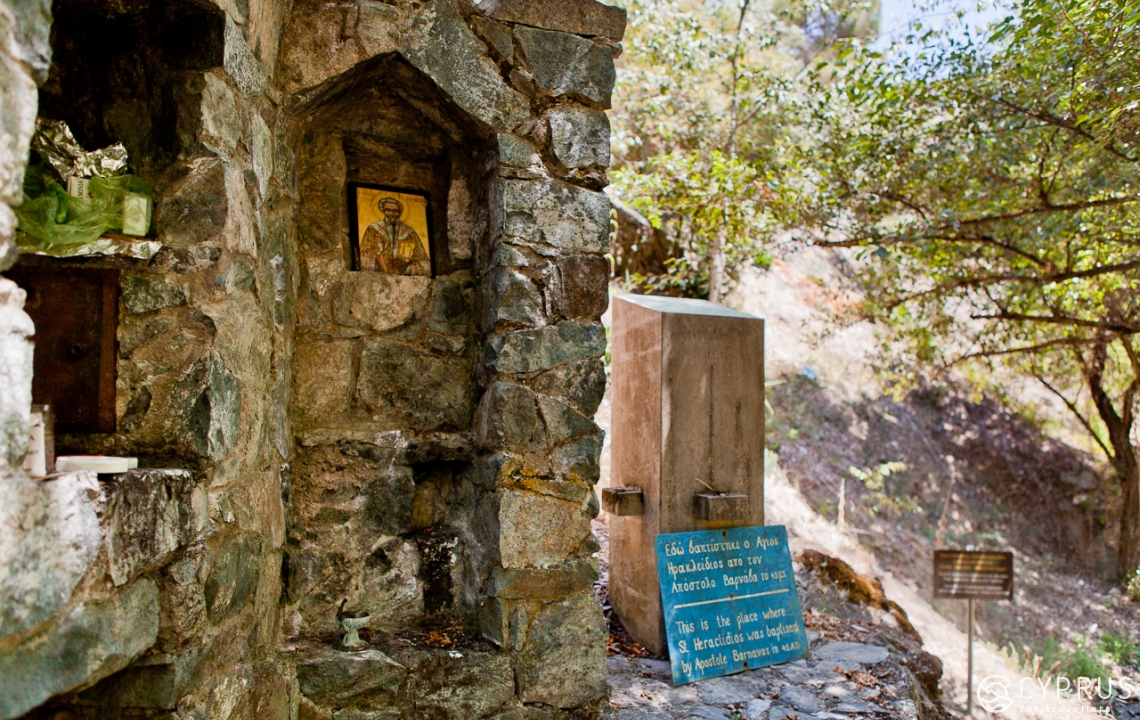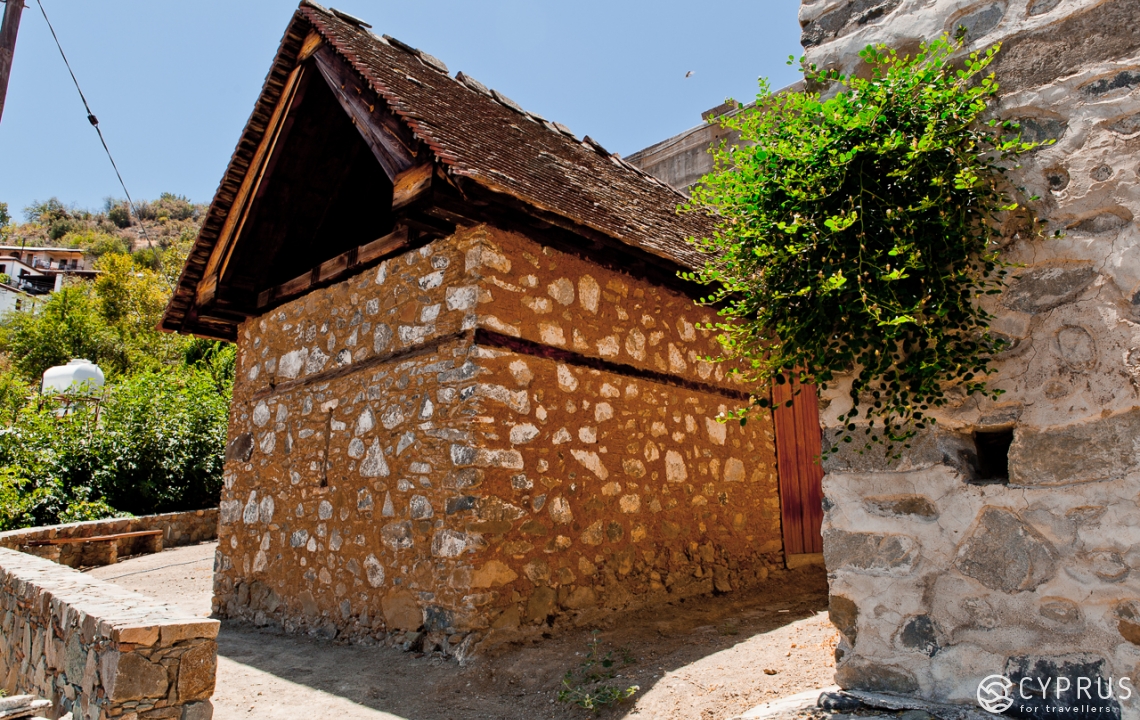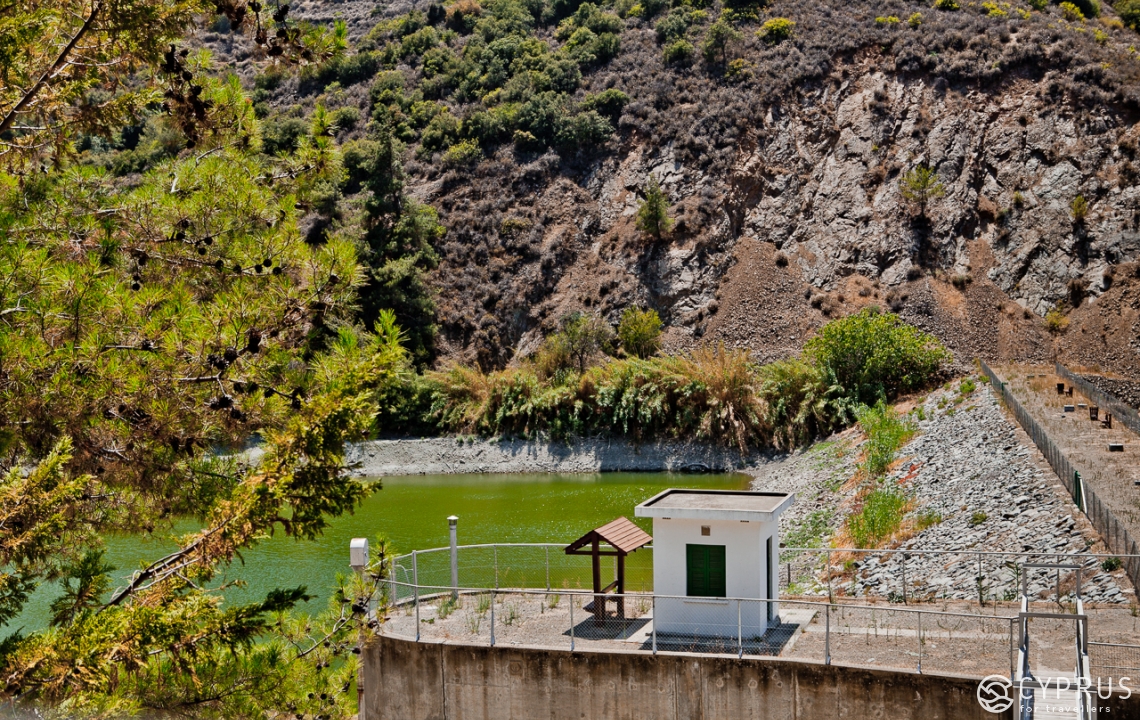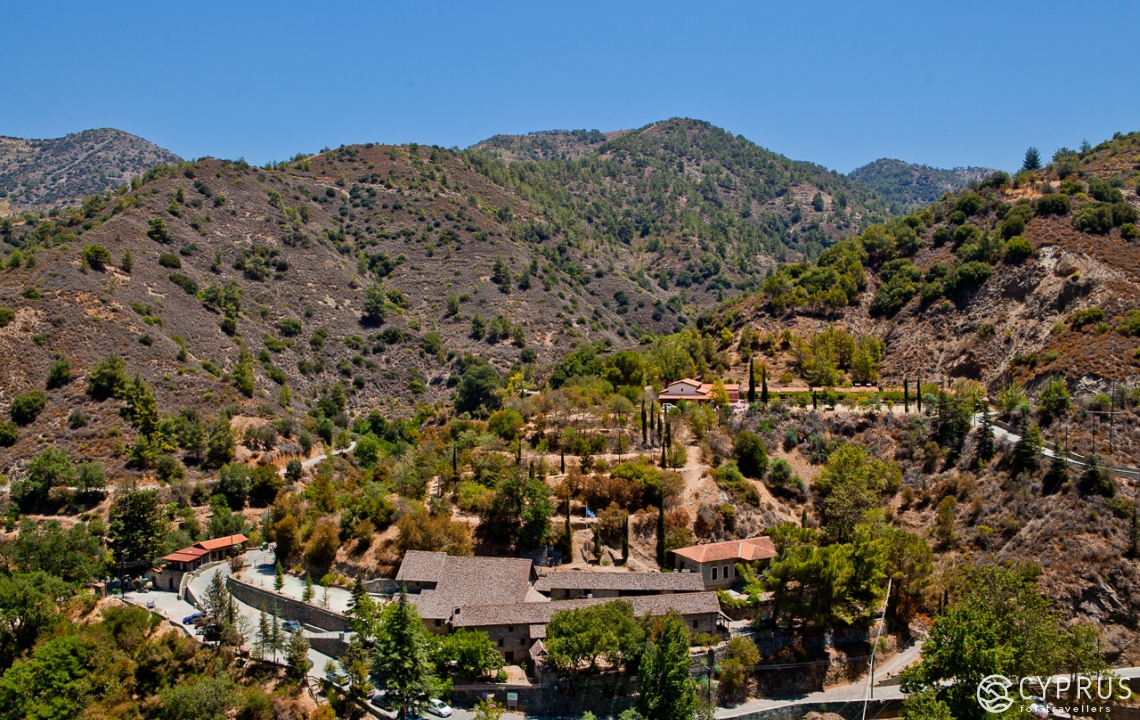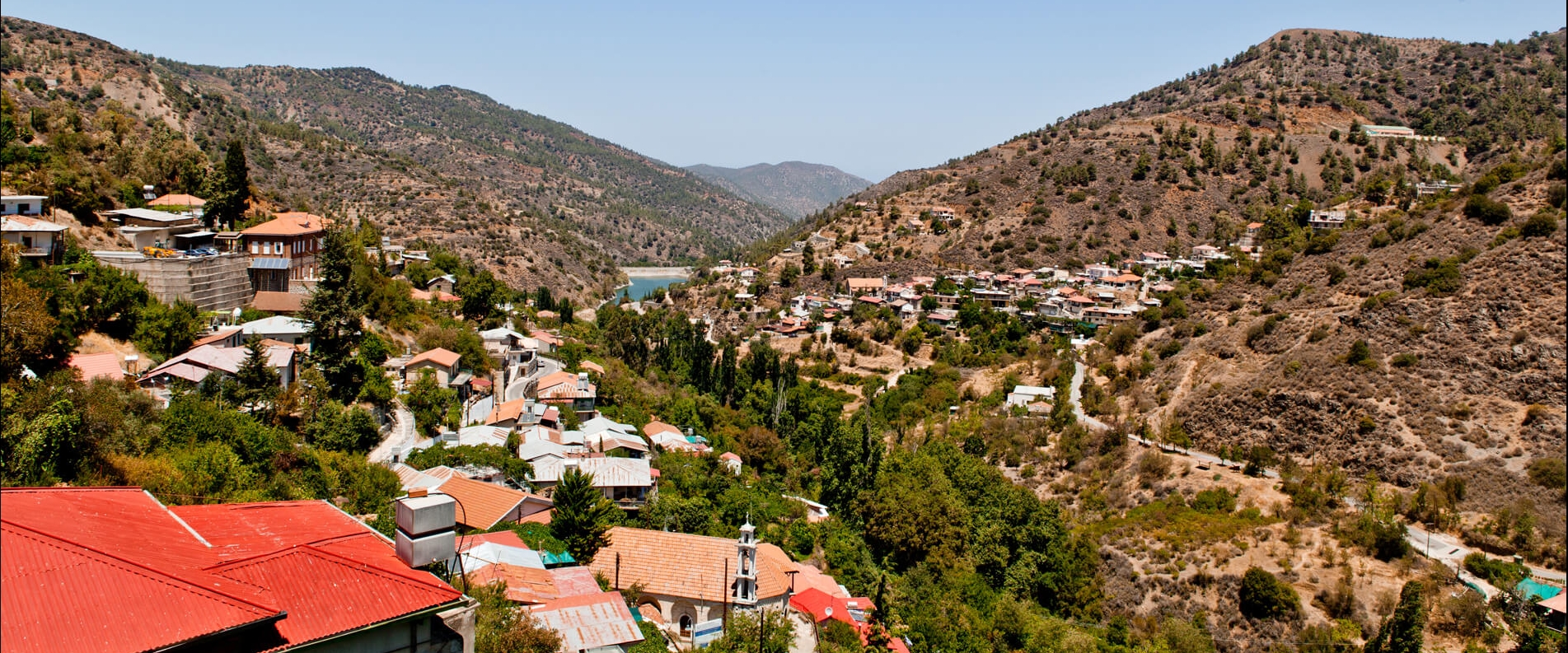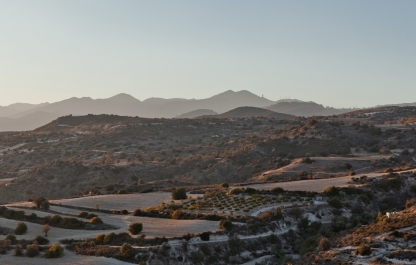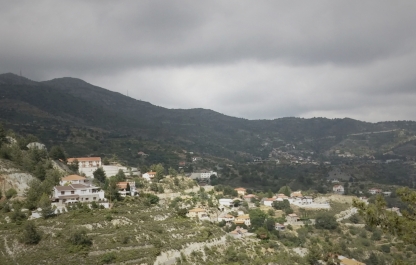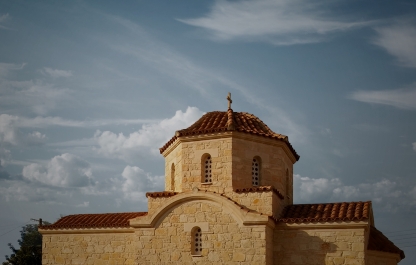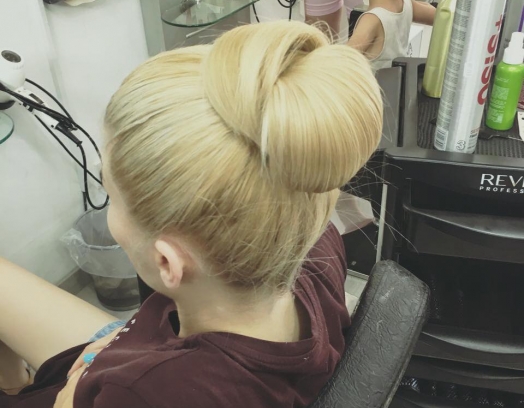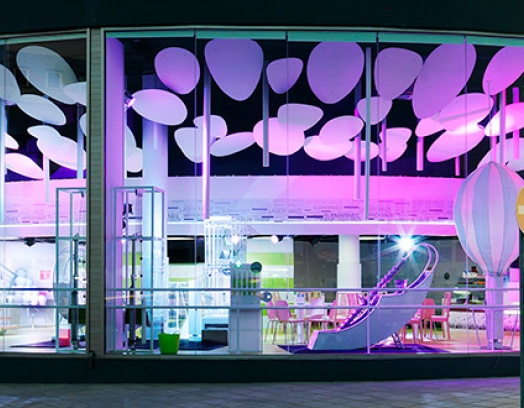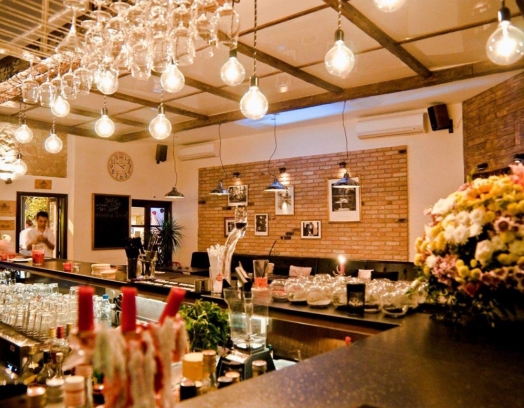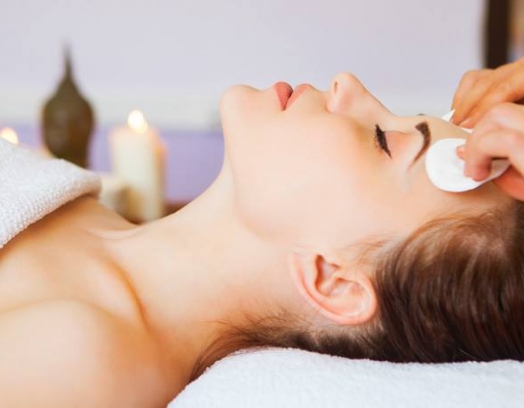Stretching out over the steep slopes of the northern Troodos Mountains, situated 762 metres above sea level in the valley of the River Setrachos, lies the historical, picturesque village of Kalopanayiotis. It has long been renowned for its natural sulphur springs and a UNESCO protected, ancient monastery, housing Byzantine frescoes. Other significant monuments representative of material culture are the Byzantine churches and chapels, as well as Venetian bridges and houses constructed in traditional architectural styles.
Well, are you interested? Then let’s talk about getting there…
After coming onto the long and narrow Markou Drakou (due to constant congestion and the number of cars parked in front of houses, many of which are retro in design) you will see several turnings between village houses drowned in thickets of jasmine and red geraniums. Beyond one of these turnings “precariously” hanging over a deep ravine, you immediately take a sharp “dive” downwards. From this point onwards a view to the monastery opens up beyond the bridge. Your car can be left on the monastery premises.
The Monastery and Saint Ioannis
The exact date marking the emergence of Agios Ioannis Lampadisitis’ unique architectural complex — one of the main Cypriot monasteries from the Mid-Byzantine, Frankish and Venetian eras — is unknown.
It was named in honour of the local Saint, famous for his miraculous healing abilities. Young Ioannis (native to Lampadou, a village which once existed not far from Galata) desired to be a monk, but his parents insisted on him finding a bride. At the age of 22, he was poisoned by his fiancee’s relatives, who had suspected him of sorcery. The relics of the monk lie in a chapel — his namesake — situated inside the dwelling.
The old monastery buildings are covered in clay tiles (in earlier church architecture, wooden, wedge-like plates, known as gonts, were used for roof work). In addition to the main, 10th-century church of Saint Heraclidios (the first archbishop of Cyprus), which has magnificently preserved some fresco works from the 12th century, the monastery’s ensemble includes: the chapel of Agios Ioannis (XII A.D.) and the “Latin” Chapel — the newest build (XV A.D.), located to the north of the main church. At around the same time, a brethren’s building was added to the church complex from the southern side of the courtyard, thus acquiring the status of monastery. From the 15th to the beginning of the 18th century, a single roof covered all buildings (hence the style “tis-stegis”).
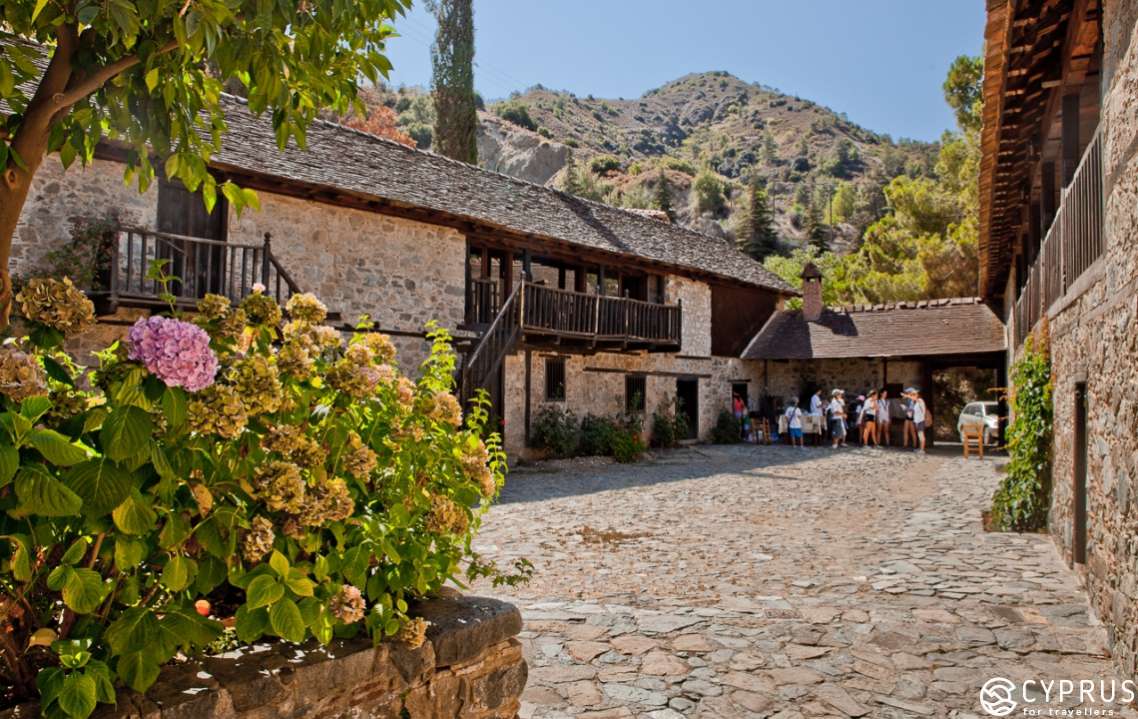
“I walked among huge mountains, clambering up ridges and descending into a valley. I spent the entire day walking through a wild forest, not knowing my way. Finally, I emerged at a village, whose residents directed me towards the monastery [of Saint Ioannis Lampadisitis]” — this was the journey log of the now well-known Russian traveller Vasil Grigorovich-Barsky (the earliest description of the monastery, from 1735).
The long uninhabited monastery, its courtyard and buildings, are now a museum complex open to the public. These small stone constructs, which together form an enclosed space, are under UNESCO protection (number 182), as one of the oldest monuments to world culture, whose interiors have preserved samples of Byzantine fresco painting. Services are held regularly in the church.
At the entrance to this territory, green with trees and flowerbeds, the main church is situated; further on — a sign for the sacristy — an ancient vestry, as well as a small book stall. The Greek flag can be seen fluttering above the brethren’s building.
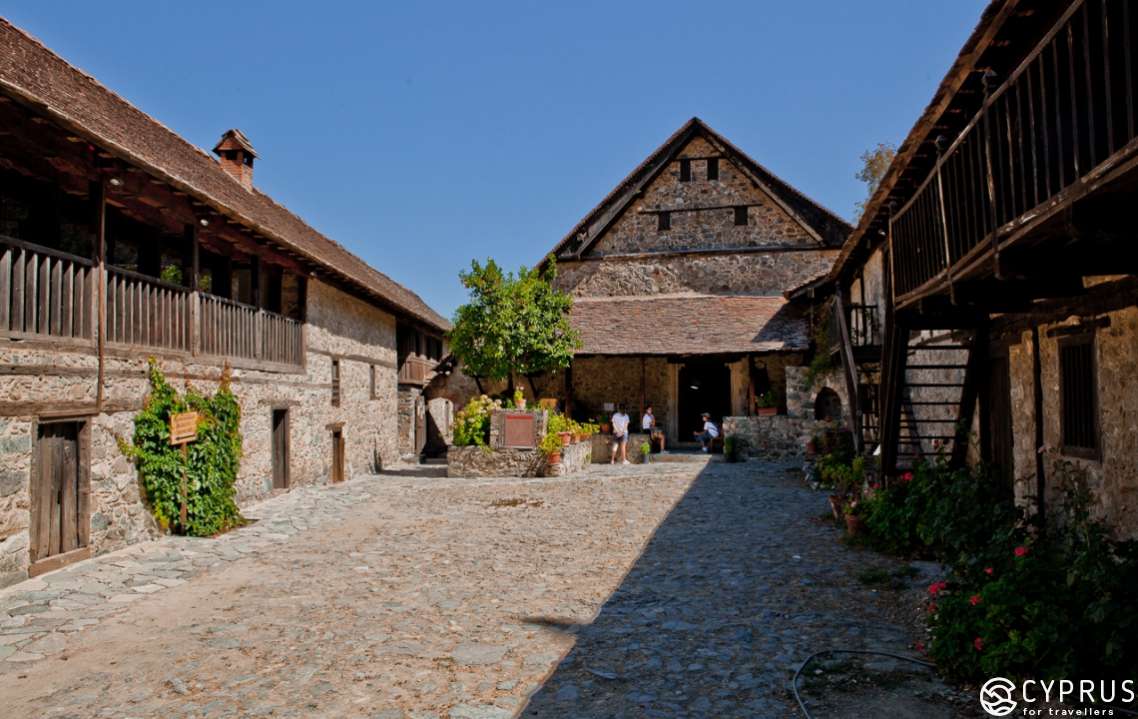
Monastery Opening Hours: Monday-Saturday from 09:00-13:00 and 14:00-16:00, Sundays from 10:00-16:00 (Winter time)
Monday-Saturday from 09:00-13:00 and 14:00-18:00, Sundays from 10:00-18:00 (in Summer).
Having passed through the courtyard and emerged at the gates on the opposite side, you can climb the stone staircase to the local Museum of Byzantine Art.
The Museum
The museum, opened to the public in the year 2000, is located in the building of a former church school. Inside, under a dimly lit spotlight, you can see magnificent works of icon painting on display, designed on wooden boards traditionally covered in a coating of ground Lefkas stone. The backgrounds on many of the large icons, however, are not traditional — they have been covered in chased copper to provide a relief effect (this tendency, as the museum supervisor Marina explained, originated in the Franco era, when large amounts of copper were being mined on the island). The exhibit mainly features icons from the 12th-16th century: Christ Pantocrator, the Archangel Michael, the Holy Virgin Mary, Saint Louka and the Apostle Peter, as well as icons of Saint Ioannis Lampadisitis and Saint Heraclidios. Some of the early images have lost their faces (as a result of long-term storage in hiding from the Ottoman-Turks), as well as precious insertions to their framing. There are also several large hagiographical icons with scenes from the Nativity, the Epiphany and Resurrection. Amongst the various relics, it is especially worth noting the framing for the Gospel (17th century) and a fragment of a carved iconostasis (14th century), incidentally one of the oldest in Cyprus.
The Museum exhibits, composed of icons and rarities, either used to be the property of the monastery or originated from ancient churches and chapels.
The top of the walls are crowned with tiers of iconostases: 16th-century icons from the church of the Most Holy Theotokos (located in Kalopanayiotis, behind the monastery), painted before the arrival of the Ottomans. An eight-point metal cross, resembling the Maltese cross, is on display at the Museum’s entrance.
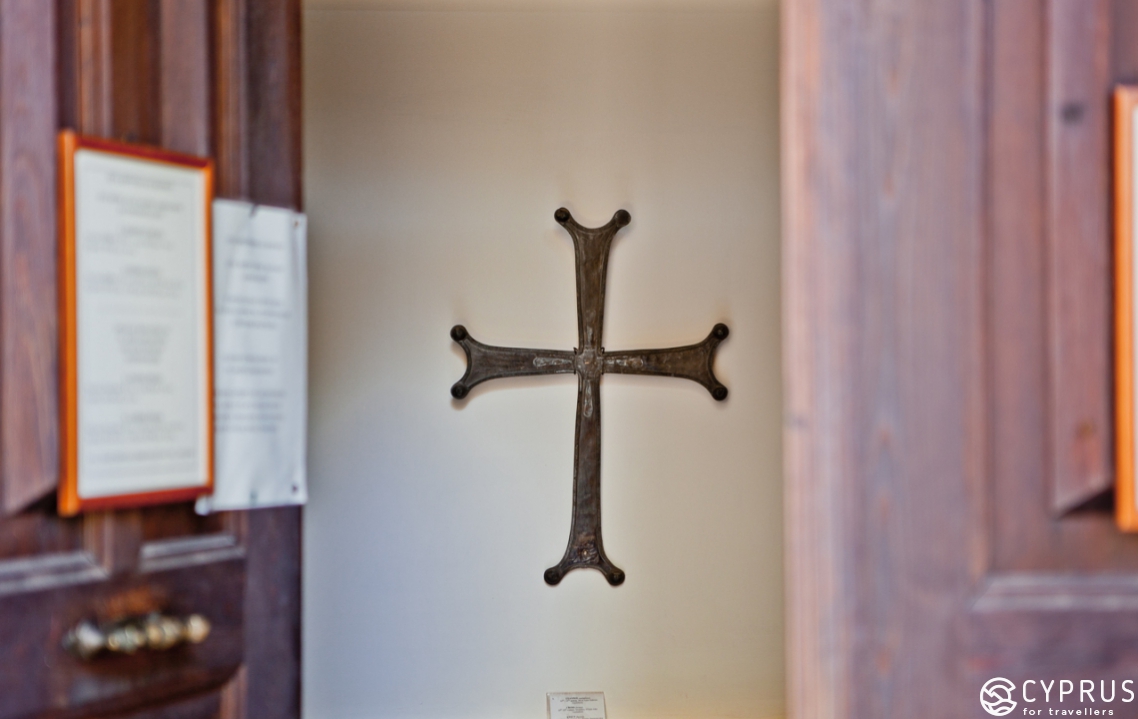
Interestingly, some exhibits were discovered earlier by experts in New York, who then returned them to Cyprus — they were bought for a substantial amount by the Holy Metropolis of Morphou. Several icons from the 14th-16th century, which disappeared from the monastery during Ottoman reign, were also discovered in Britain and consequently returned to Cyprus.
Please note that all Museum signs and information are available in three languages: Russian, Greek and English. In the hall, you will also find literature dedicated to the exhibit, the monastery’s history and the life of Ioannis Lampadisitis.
Museum Opening Hours: Mondays-Saturdays from 09:00-13:00 and 14:00-16:00, Sundays from 10:30-16:00 (Winter time)
Mondays-Saturdays from 09:00-13:30 and 14:30-18:00, Sundays from 10:30-13:30 and 14:30-18:00 (in Summer).
Entry Fee: 1 Euro
Tel: +357 99218298
The River and Springs
After visiting the monastery and going to the museum, don’t hurry back to the village itself just yet. Here you can see a shaded alley stretching out with a stone embankment and benches on the rocky bank of the mountain river Setrachos (formerly Solion). Not only should you feast your eyes on the marvellous view, the freshness of the green cinnabar and the noisy current racing through the stones, but this is also a fantastic opportunity to see a 16th century stone bridge — an arch span, built using traditional stone masonry — from Venetian times. Until recently, it served as the only connecting junction between the village and the monastery.
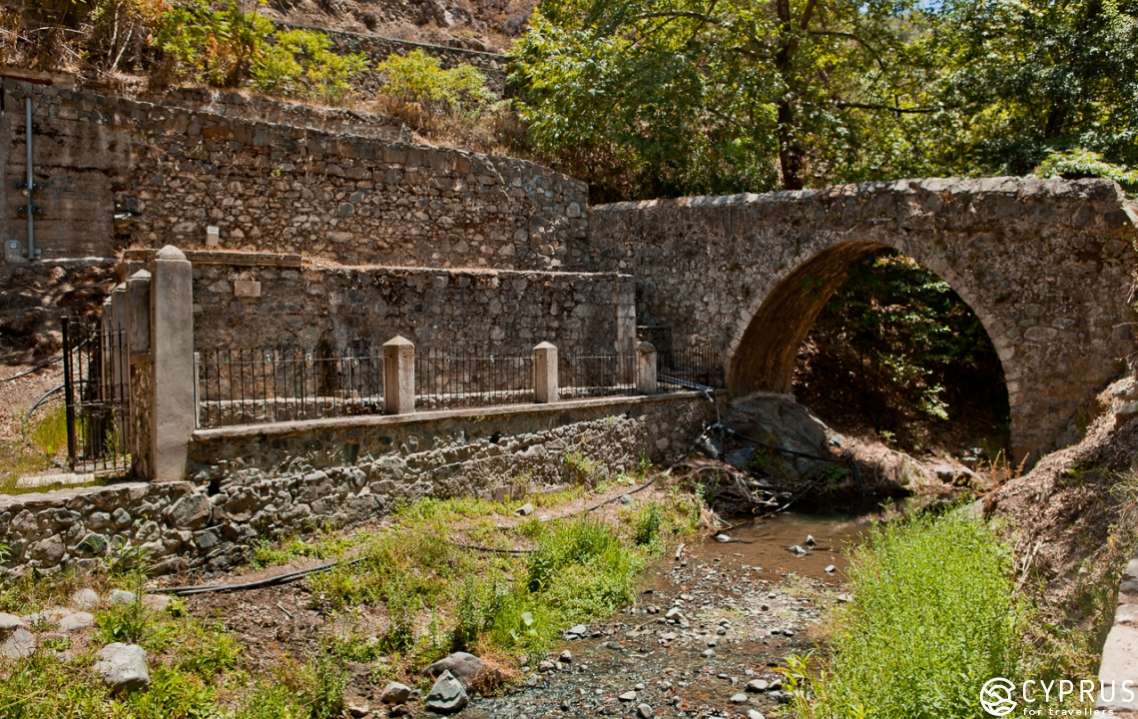
Continuing along the “promenade”, be sure to make it up to the sulphur spring.
On a lower decline to the north of the monastery, you will find a spring of healing water; two springs, to be more accurate, flowing over both slopes. They have been sheltered in small stone caves, which are monitored by an attendant living in the vicinity.
The water from the first spring is used to treat diseases relating to the digestive tract. To reach the second, you must cross the bridge and go over to the right-hand bank of the Setrachos. Its water is for external application, used to treat skin and rheumatic diseases.

To those “experienced” travellers: if from the monastery car park you drive on further to the fork between Pavlou and Varnavas and Panagias Teoskratis street, you will get achance to enrich your impressions of the surrounding area: go to the right and you will see the rather unique little Church of Panagia Theoskepasti (literally: “The Virgin Mary, veiled by God”). The church is famous for having saved residents of Kalopanayiotis in olden times: it couldn’t be seen from the road and so during foreign raids, people would regularly conceal themselves inside it. Nearby lies a giant, ancient oak tree, while on it a bell hangs… an unexpected inlet of the sea, at which point one of the nature trails begins.
If, however, you choose the route to the left… you won’t make that mistake again: at 690m above sea level, another nature trail begins here for those lovers of hiking (along the River Kokkalas), where interesting sights and possibly, discoveries, await you.
The Cradle of Christianity in Cyprus
To the right, while travelling from the monastery to the village, not far from Lampadisitis bridge, you will notice a small, contemporary stone-carved memorial sign with a fresco. It marks the beginning of the trail, leading to another revered place in Kalopanayiotis, which remembers the apostles Paul, Mark and Barnabas. In the year 45 A.D. they walked along here, bearing the Christian faith, with their island guide, a Cypriot named Heraclidios. It was this very spot where the apostles baptised Heraclidios (the future metropolitan), — and nowadays, in the damp gloom of the ravine, a memorial sign lies secretly hidden in the mountain current.
While descending the steep trail, listening only to the water’s monotonous roaring and surging, you are involuntarily filled with a feeling of profound awe.
Have you ever noticed that when visiting a place of particular significance, you are pierced by a connection with time: this isn’t so much a connection with bygone eras or generations (for the sensation of time simply disappears here), as a feeling of being interconnected with history and miracles…
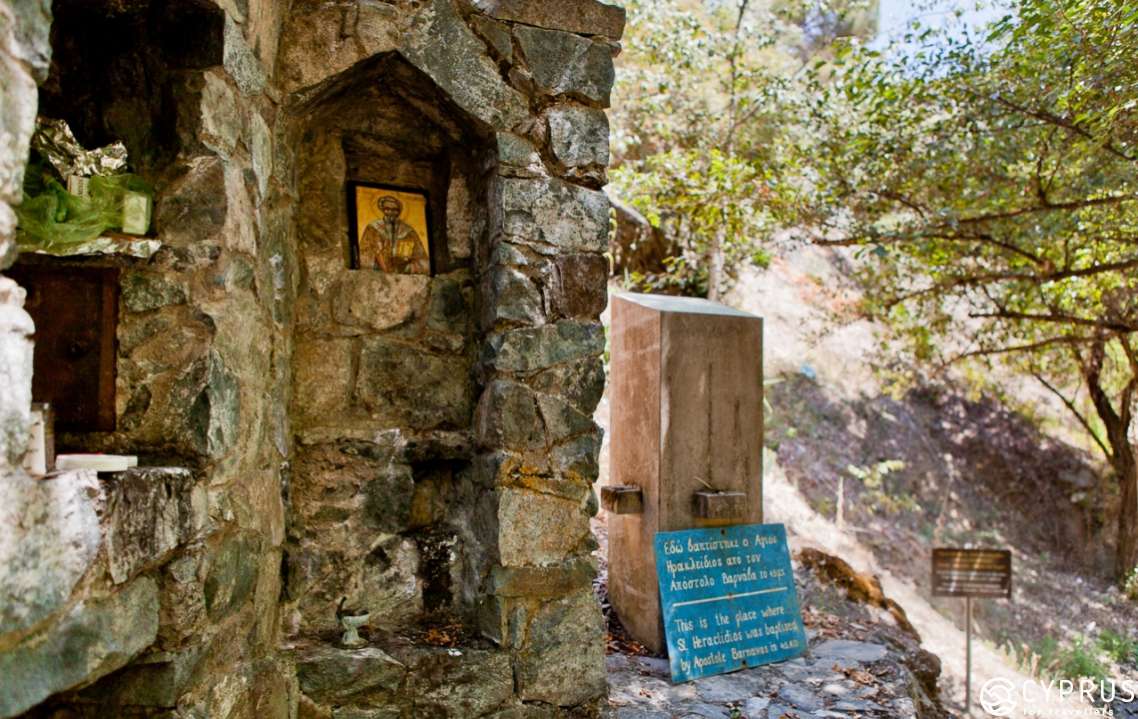
The Village and its Residents
It seems we’ve managed to acquaint ourselves with the main sights in the village vicinity, so it’s time to go for a saunter and look at how Kalopanayiotis lives today.
After crossing over a bridge “soaring” above the canyon, we have now arrived.
Once again, a little history filters here and there through the freshly decorated facades, the hanging balconies and openwork lattices, enlaced in unruly garden plant branches.
The village, considered “only” to have first been inhabited in the 11th century, was part of the ancient kingdom of Soli and has been renowned for its healing springs since the age of antiquity. It was once often visited, upon recommendation of ancient miracle healers, by disease-afflicted rulers, who would successfully combine their healing procedures with hunting trips into the local thickets.
However, it was with the foundation of the monastery in particular (on the spot of the former sanctuary, dedicated to Asclepius) that development of buildings began and the village appeared.
In fact, as legend tells, the locals in the past were renowned for their piety and sought to erect temples and chapels in the area (which in the village itself were truly great in number: Agia Marina, Agios Georgios, Agios Andronikos, Agios Sergios), but the best of them was, of course, Panagiotis, a good (“kalos” in Greek) man, after whom the village was named.
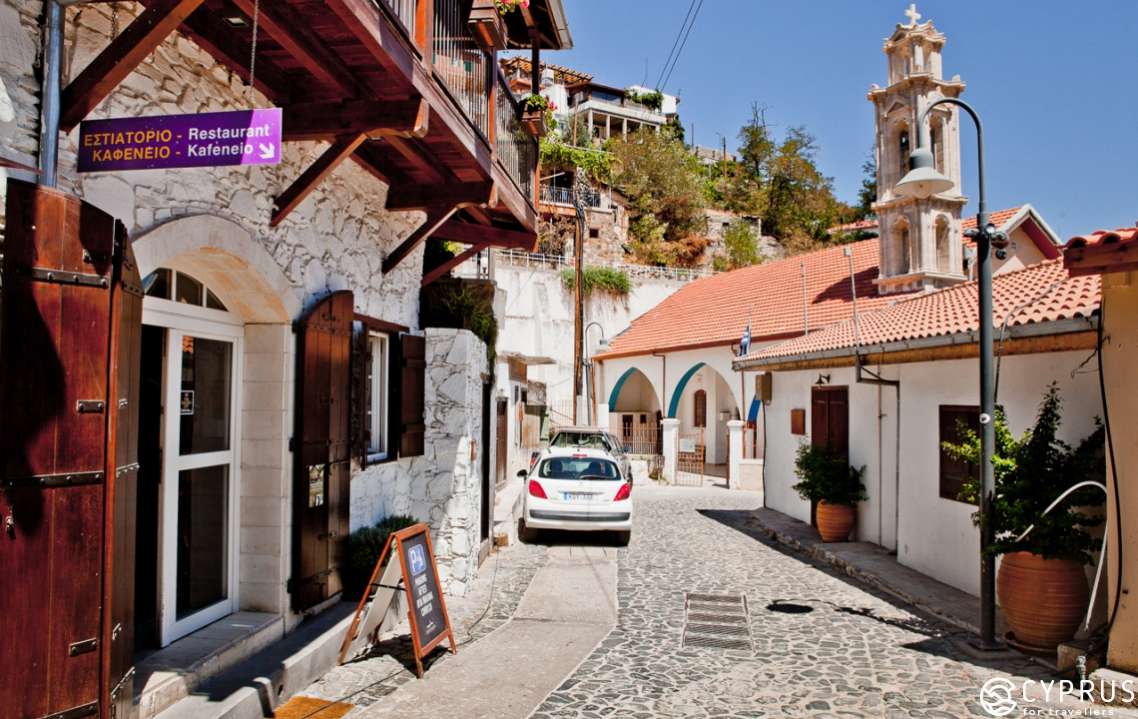
For those who love active evening or cultural events, its worth remembering that Kalopanayiotis is not a tourist centre. In the evening people get together in bars, cafes and restaurants on the main street and in the district.
From time to time the Cultural centre is open for holding various events; artists and musicians are invited to play and sing, mainly for tourists, but a life of creativity and entertainment is absent here.
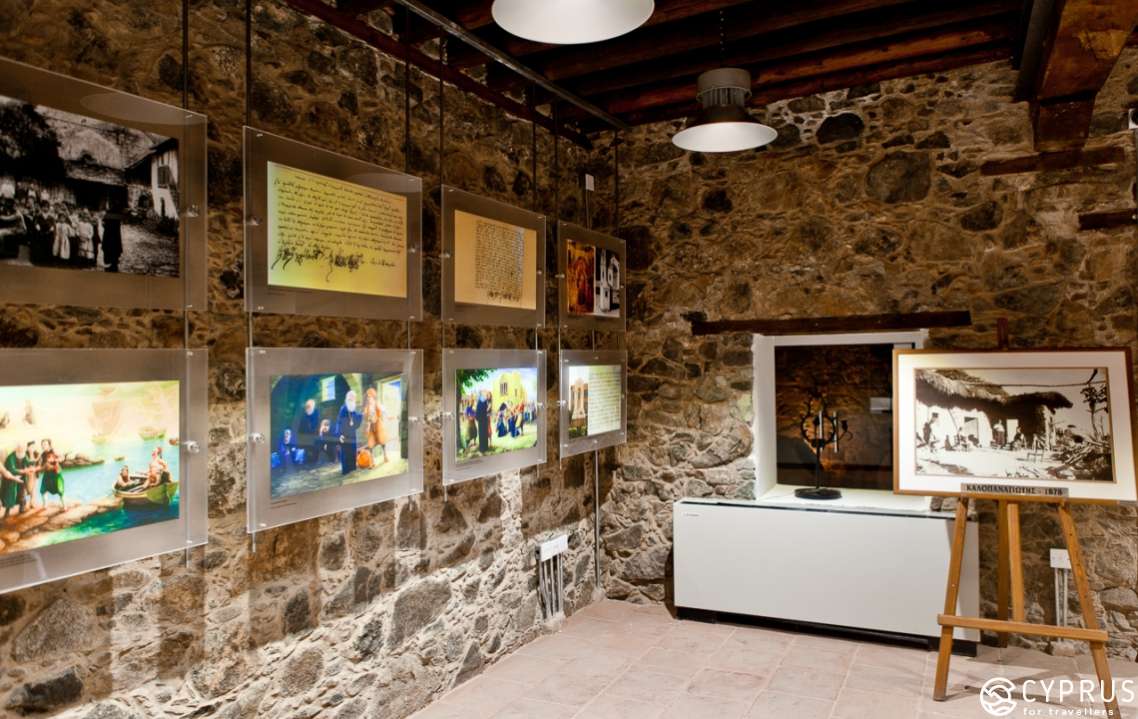
In spite of this, Kalopanayiotis is a very popular destination for Cypriots, especially at the weekend and on long summer days: people practise sport here, walking tourism or relax in the local spa.
The locals, aside from actively partaking in agro-tourism, providing tourists specially equipped traditional homes for temporary lodging, also manage apiaries and manufacture sudjuk (a sweet made from grape must, resembling the well-known churchkhela) and wooden barrels.
As such, for the weary traveller, grabbing a bite and taking a rest won’t pose any issue (as is practically the case everywhere in Cyprus). For instance, lunch in the local restaurant of hotel Casale Panayiotis will cost you about 20-25 Euros: lunch in the village cafe — around 10-12 Euros.
And so we have learnt a little more about Cyprus, its people, history and traditions. Having gathered a collage of our experiences today, we have acquainted ourselves with Kalopanayiotis, which holds a special place in the ancient history of the country… but many such places still remain, and they are waiting for us!
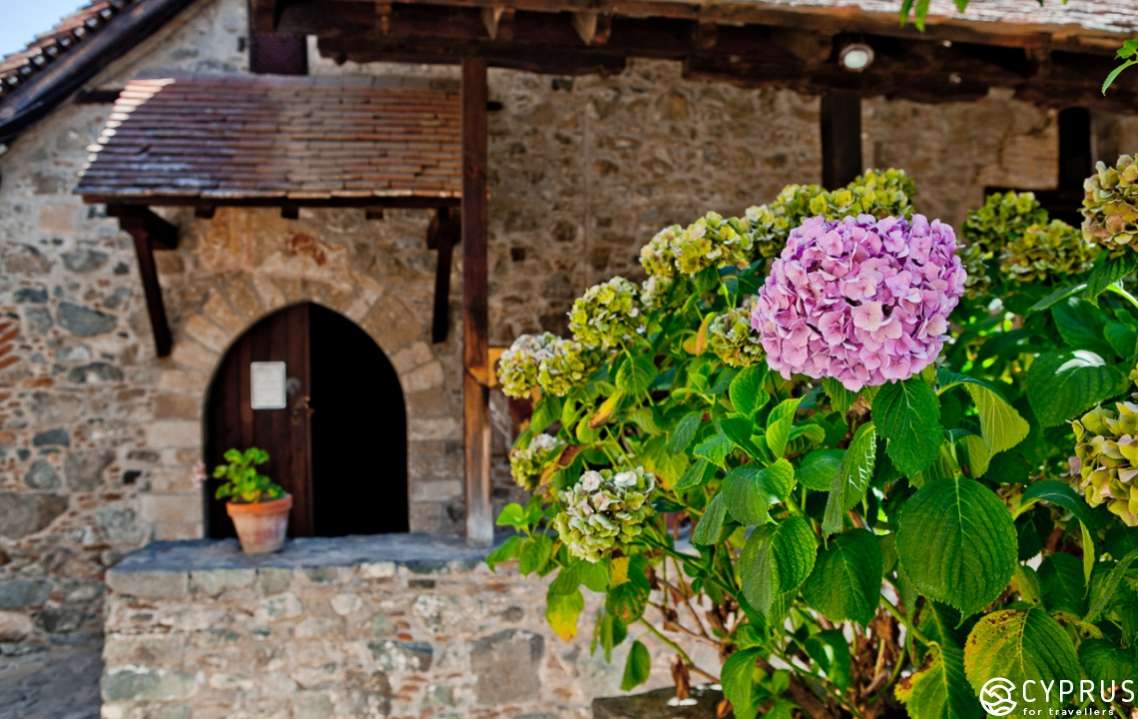
Useful Advice:
Summer in Cyprus “officially” lasts from the 16th April to the 15th September inclusive.
The red geraniums along the winding mountain road are a trademark of Kalopanayiotis, so if you’re coming here for the first time, don’t be afraid to get a little lost… that being said, not everywhere is signposted.
The village has several main parking spots, on Markou Drakou (by the Church of Agios Georgios and Agnumenon Square), on Panagias Teotokou, on Poiadgi Square (opposite the Government building) and on Agia Ioanna Lampadisitis (Iroun Square); further away, on Agoniston Square (not far from a factory which produces sudjuk — traditional Cypriot sweets).
Take a canister, flask or plastic bottle with you on your travels: you’re going to visit the curative sulphur springs, after all, for which Kalopanayiotis is renowned.
Sports or low-heeled footwear would be our choice: you will have to walk along very windy side streets, which both dive down steeply and soar up the mountain spurs. Many of the streets in the central part are cobbled.
A viewing funicular also operates in the village: instead of the complicated, albeit exciting ascents and slopes along the streets of Kalopanayiotis, you can simply ride the lift for a euro to both ends while taking in your picturesque surroundings.
Getting there: It’s easy to reach the village from Nicosia and Limassol, as well as from Larnaca and Paphos international airports.
From Nicosia — drive 70 km along the A9 and B9 highways, then the E908 road, passing through the villages of Akaki, Astromeritis, Koutrafas, Linou and Katidata, heading for the monastery of Kikkos.
From Limassol — 75 km, along the B8 highway (and the E801 road), the B9 (the E908 road) — through Saitas and Amiantos, heading towards Kakopetria, Evrichou, Linou and Katydata.
Have a fantastic time and see you soon!
